Cambodia is very flat and we drive for miles past identical scenery. Brown fields which will grow rice in the wet season, scrawny cattle and very basic homes.
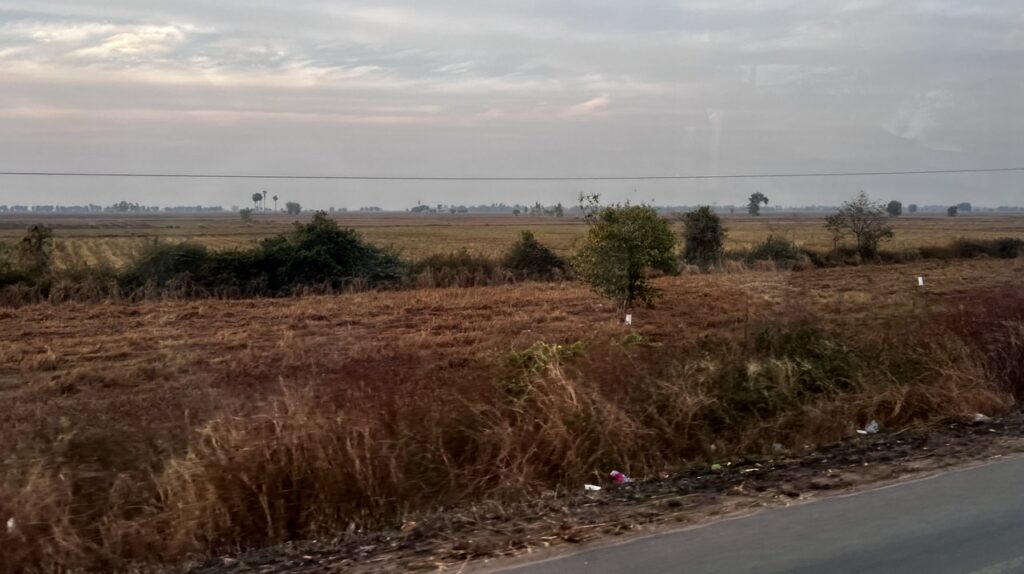
Most people here are farmers and very poor. Although the Khmer Rouge were defeated by Vietnamese troops in 1978 the actual war did not finish until 1998 with the death of Pol Pot. At that time people had nothing and have had to rebuild from scratch ( more on that later…) There is ribbon development pretty much the whole way along the roadside, but of simple shacks where people sleep (mainly in hammocks) as well as work.

Five hours after crossing the border we approach the capital Phnom Penh. Skyscrapers appear and smart buildings. This is in stark contrast to everything we have seen and comes as a shock and we shall learn more about this from our guide. A quick freshen up and then a sunset cyclo tour of the capital city.
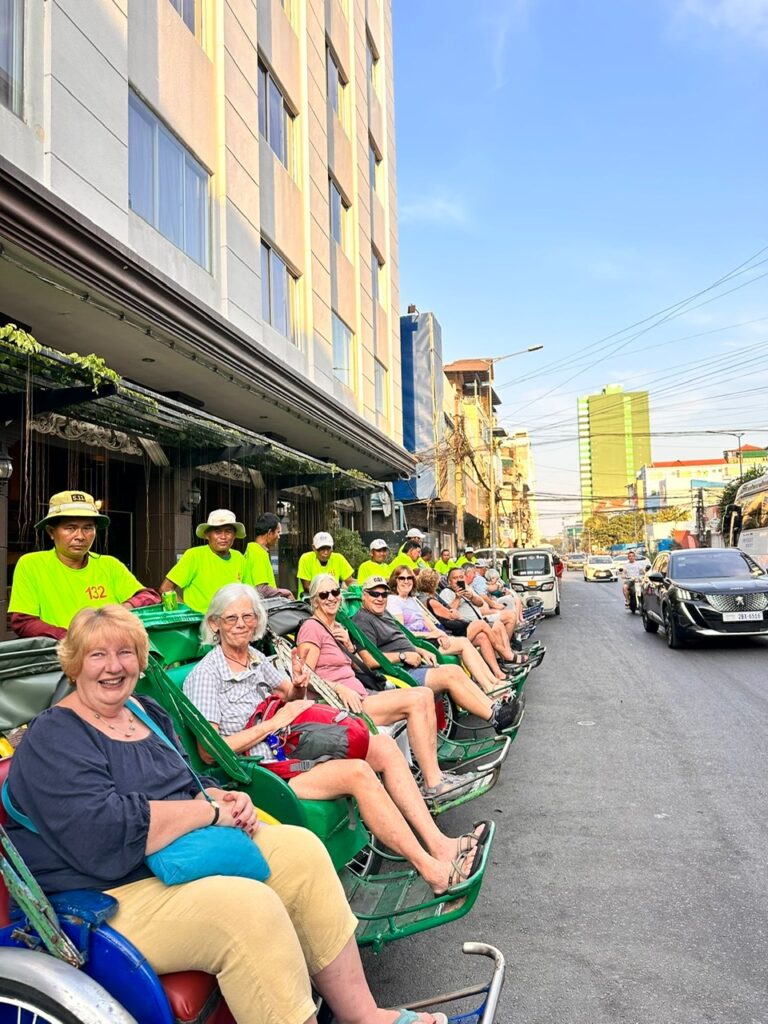
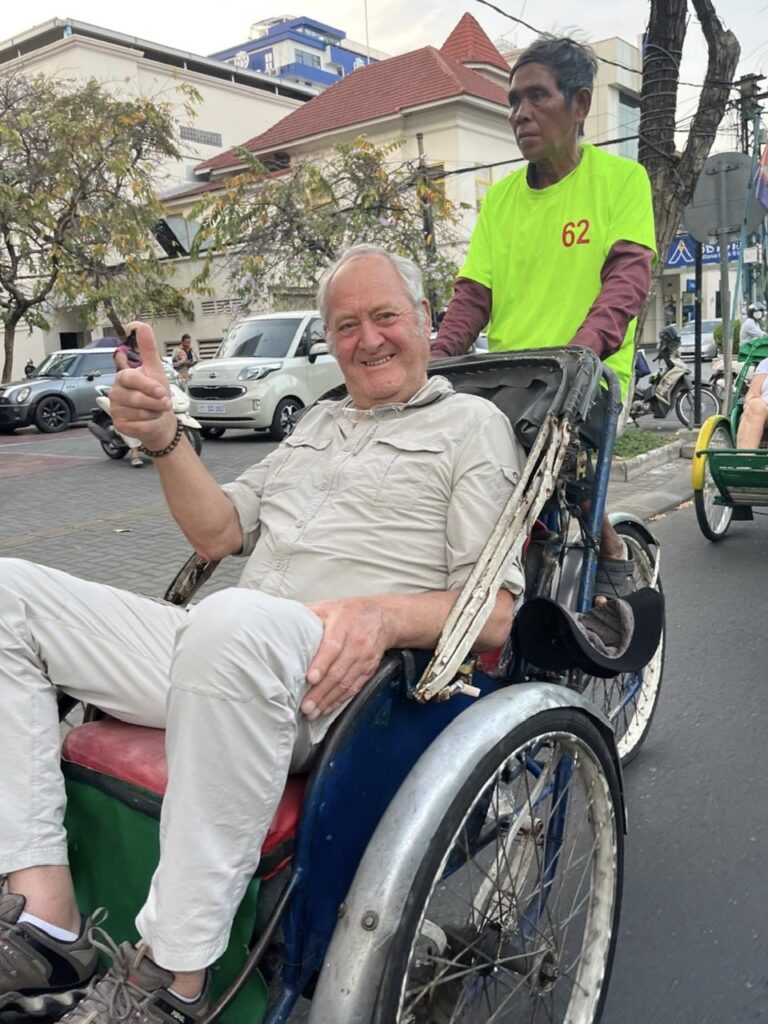
First stop is Wat Phnom – a Buddhist pagoda built on a man made hill. It houses four Buddhist statues found inside a floating cedar tree by the lady Penh and built by her. Phnom means mountain, hence the capital city name of Phnom Penh. In front of the temple is a giant clock some 20 metres wide.
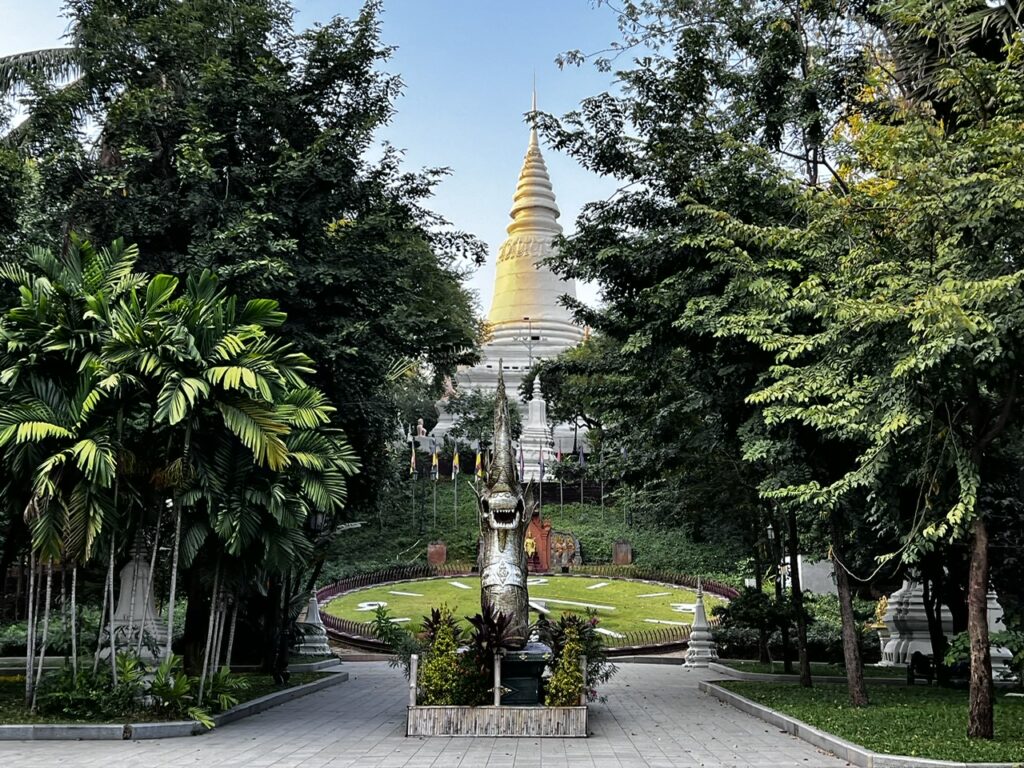
We cycle past Independence Monument which is surrounded by fountains.


This marks the eastern end of the memorial park where people exercise, play games, relax and drive around in smart cars.
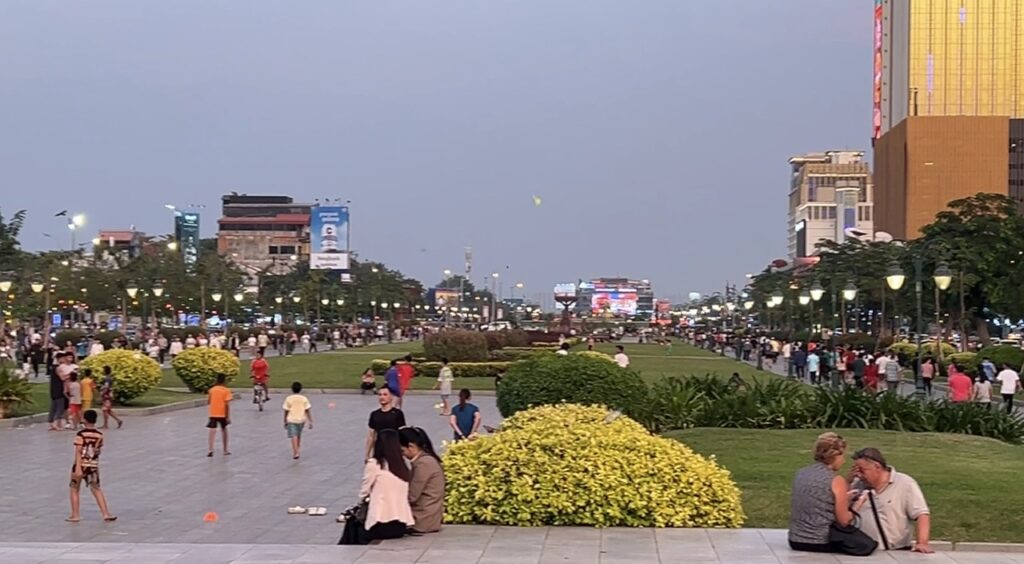
There is great wealth here in stark contrast to the poverty everywhere else in the country. To the west of the Independence Monument is a statue of former King Norodem Sihanouk, built in 2013 at a cost of US$1.2 million.

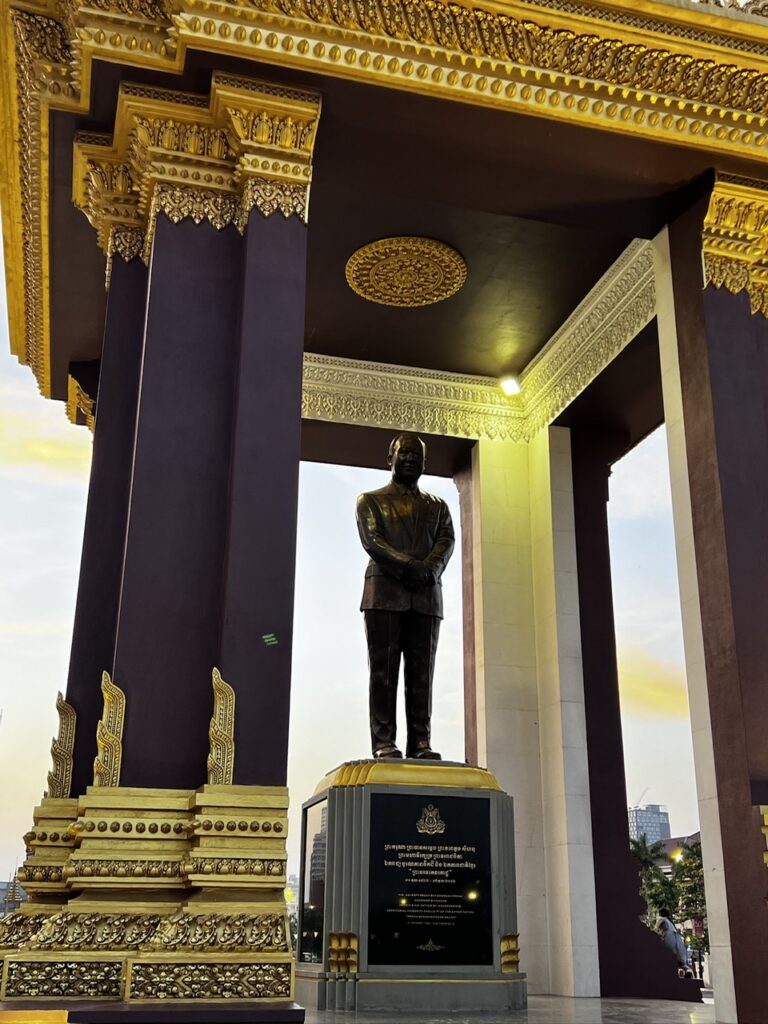
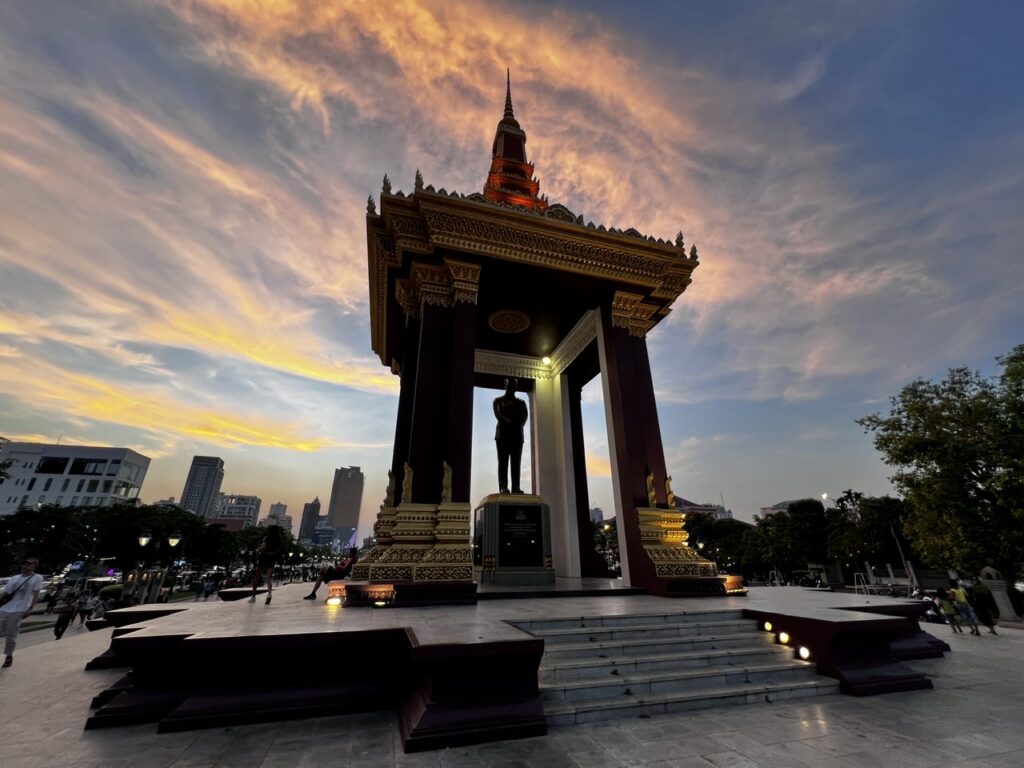
We cycle past the Palace. Our guide tells us that it has floors made of solid silver, whilst opposite the palace, street stalls sell piles of crispy insects to eat. This is now a local delicacy, and came about as a result of the war where people were so hungry that in desperation they took to eating insects.

Our guide says he cannot say too much in public but all the development is foreign investment and mainly from China. They have elections but they have had the same Prime Minister for nearly 40 years and he has now been succeeded by his son. In the last elections there were 18 parties but over 90% of the votes went to the Cambodian Peoples Party… Make of that what you will. To date only five members of the Khmer Rouge have been prosecuted for their crimes. Many government offices are now held by ex Khmer Rouge members. We are told that people are not happy with the political situation. They can neither forgive nor forget… but if they do not want more conflict they must accept. And accept they do with huge grace and dignity. They are the warmest and friendliest people we have met and with a determination to re-build their lives and look to the future.
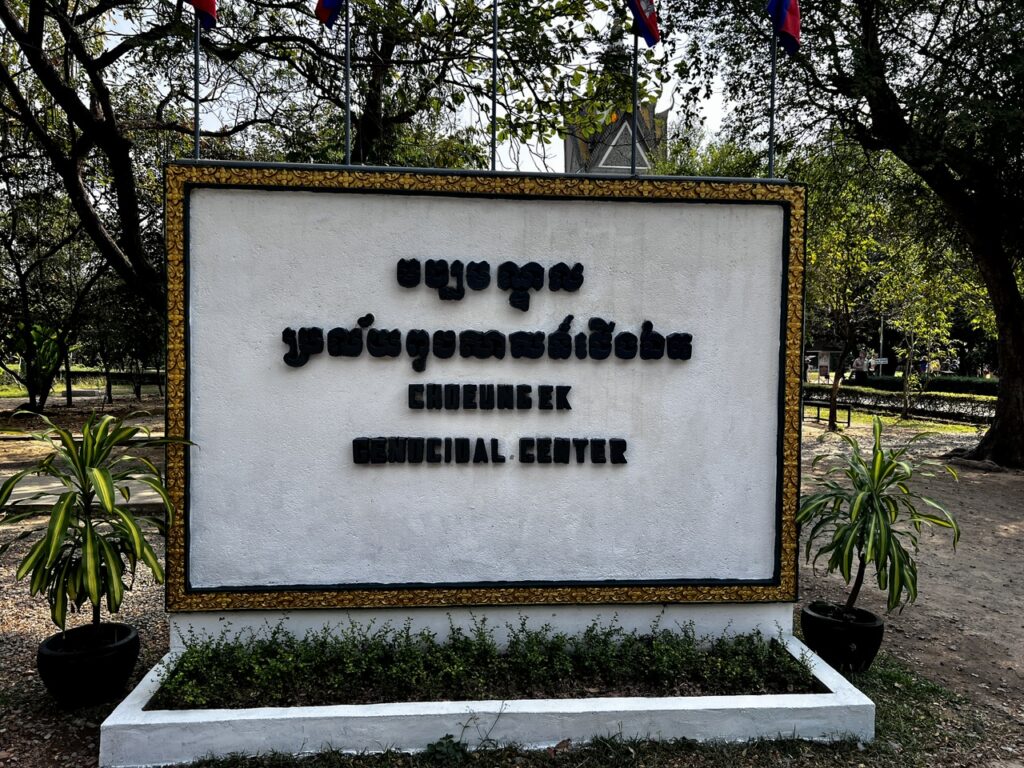
Today will be traumatic. We shall visit Choeung Ek Genocide Centre, which was one of the mass killing fields (to date 363 such sites have been identified). I can understand people not wanting to visit, but personally I could not come to Cambodia and not face the truth of what happened here. This recent history has defined the country as it is today. Of course, it will be difficult and upsetting, but I think if I want to understand the people and the country it is a story that needs to be heard.
So briefly what happened? The Khmer Rouge seized power on 17 April 1975 and their rule of terror lasted until 7 January 1979, when they were overthrown by the Vietnamese. (NB The war continued until 1998 when Pol Pot was killed). That is just 3 years, 8 months and 20 days. In that short time it is estimated 1.5 million died from execution and up to a further million died from disease and starvation. The total population of Cambodia at that time was only 7 million so roughly 30% of the population died. The Khmer Rouge swept into Phnom Penh and were greeted by happy and cheering crowds who believed that this would give them a better future.
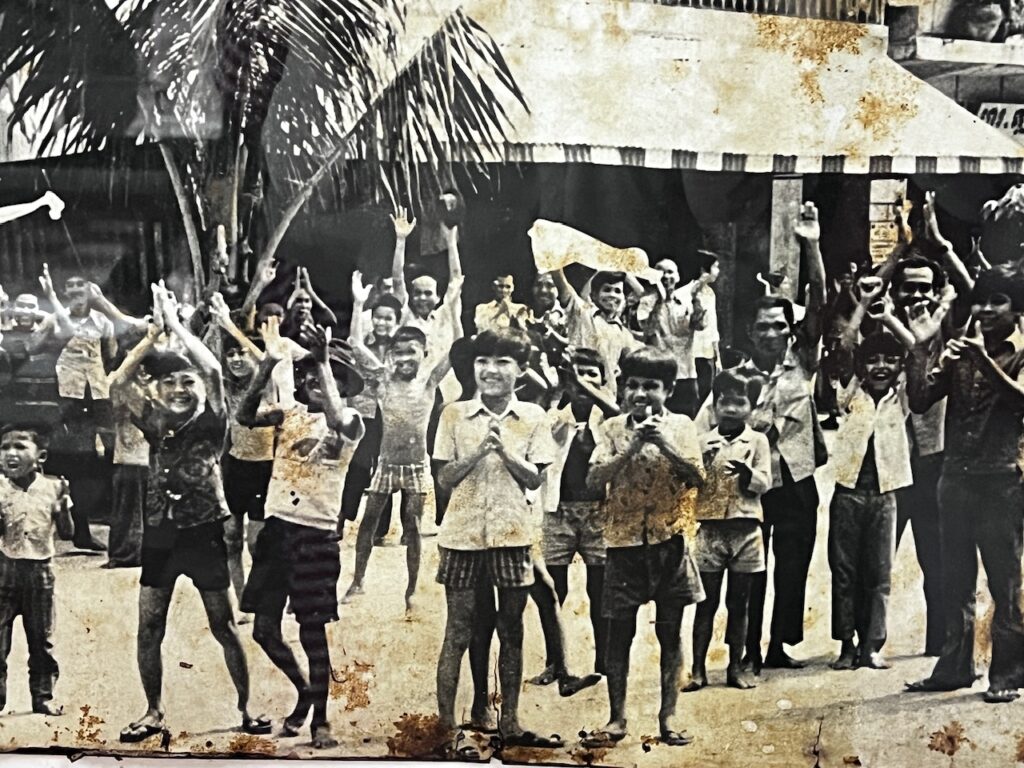
They were lied to. Within 3 hours the killing had started. Everyone was told to leave the city and that they could return in 3 days when any dissidents and terrorists had been cleared. They never returned but were made to work in the rice fields. 1975 was declared “Year Zero”. Any signs of capitalism were abolished. No currency, schools, religion, businesses. All clothes had to be died black. Anyone who appeared to be an intellectual e.g wore glasses, soft hands or spoke a foreign language was executed. As well as any political opponents. Our guide tells us that his mother only had two cups of rice porridge a day and that there was so little rice you could count the grains. Everybody is working in the fields and growing rice. Why so little to eat? The majority is believed to have been exported to China. The Khmer Rouge were largely funded by China (over 90% of foreign aid received at that time).
Today Choeung Ek is a memorial, marked by a Buddhist stupa.
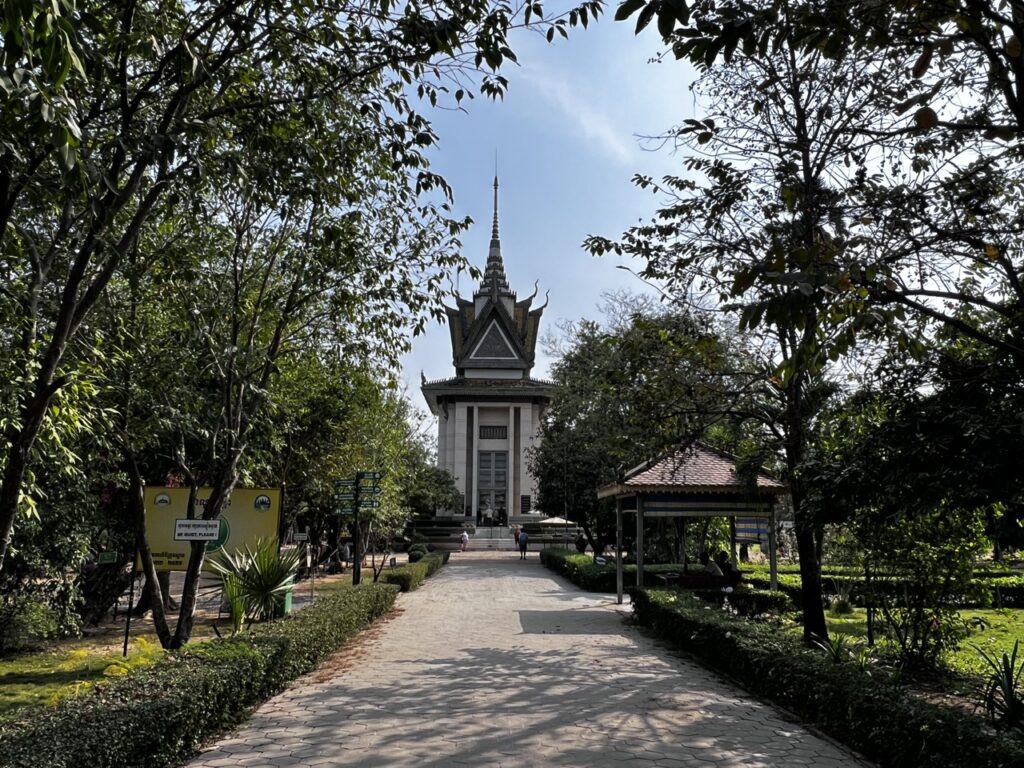
It has acrylic sides and contains over 5000 human skulls. It is a very powerful tribute to the dead.

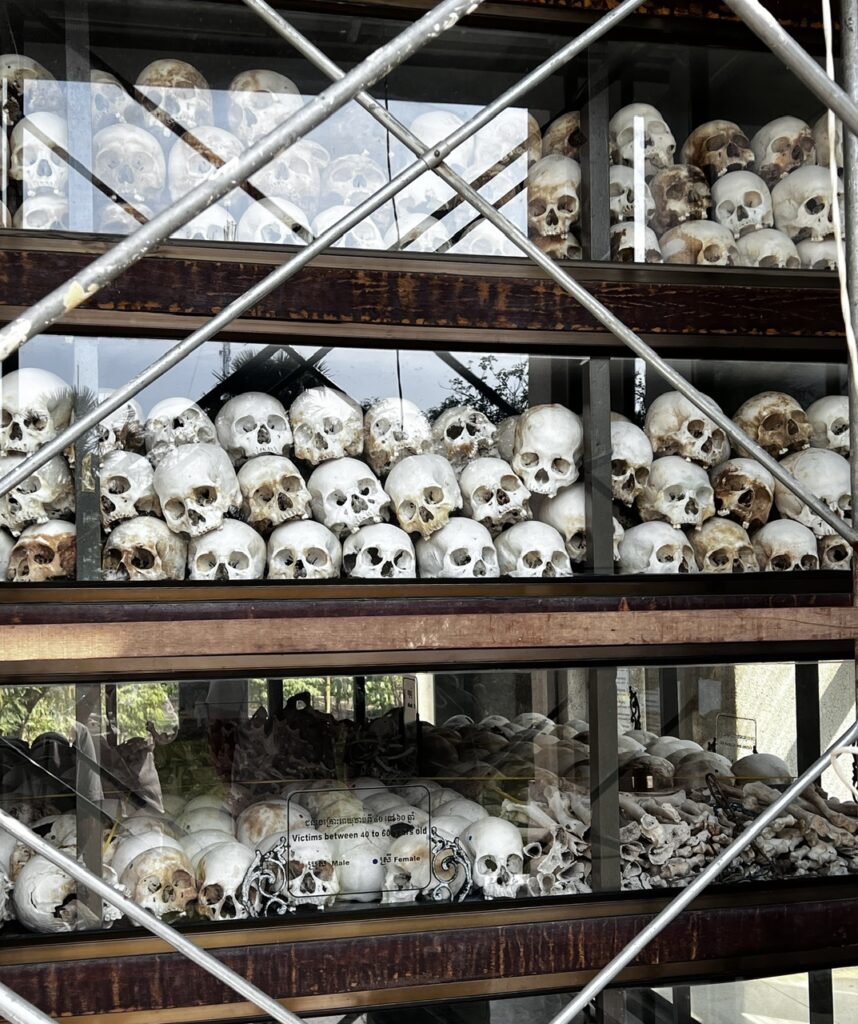
From 1995 to 2007, the Documentation Center of Cambodia has set about the difficult – and often disheartening – task of mapping the Cambodian killing fields. Through interviews and physical exploration, DC-Cam identified 19,733 mass burial pits, 196 prisons that operated during the Democratic Kampuchea (DK) period, and 81 memorials constructed by survivors of the DK regime. Many of those sites contain – or once contained – the remains of thousands of victims, and they are located throughout 170 Cambodian districts and almost all of Cambodia’s provinces.
Documentation Centre of cambodia
We walk around the sites of the mass graves. It is estimated that there are probably about 20000 bodies here and so far 8895 bodies have been exhumed. Many graves remain undisturbed. Loud music was played whilst the executions took place to hide the sound of people being bludgeoned to death.

Other mass graves are fenced off and plaques give the horrific details…
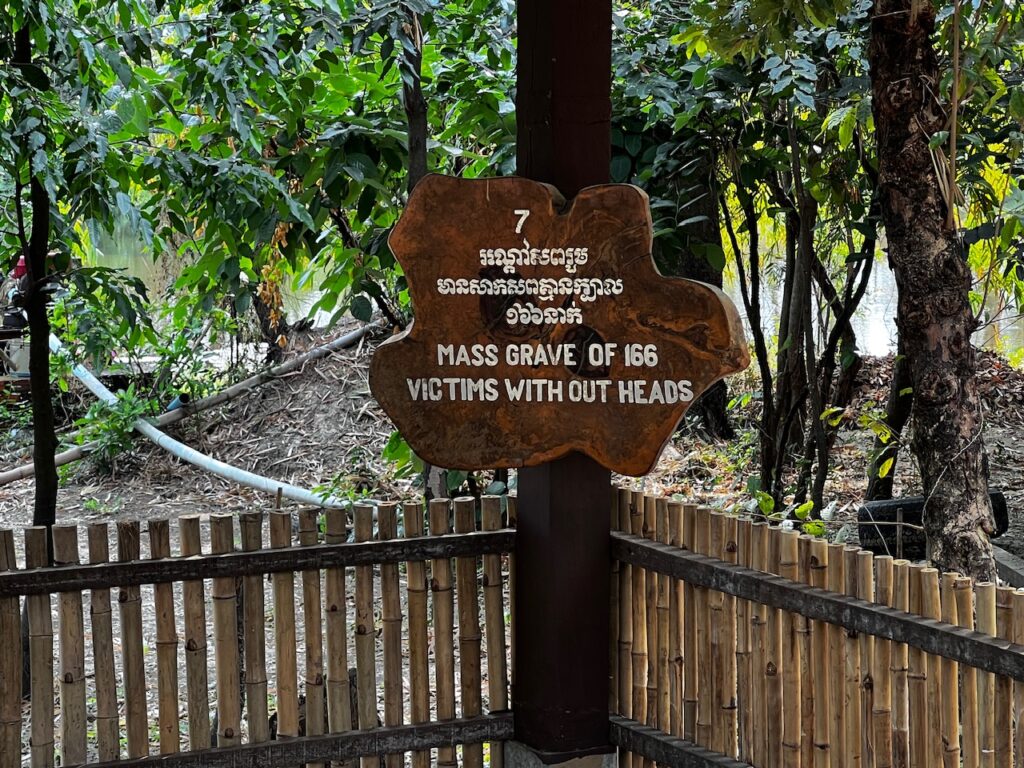

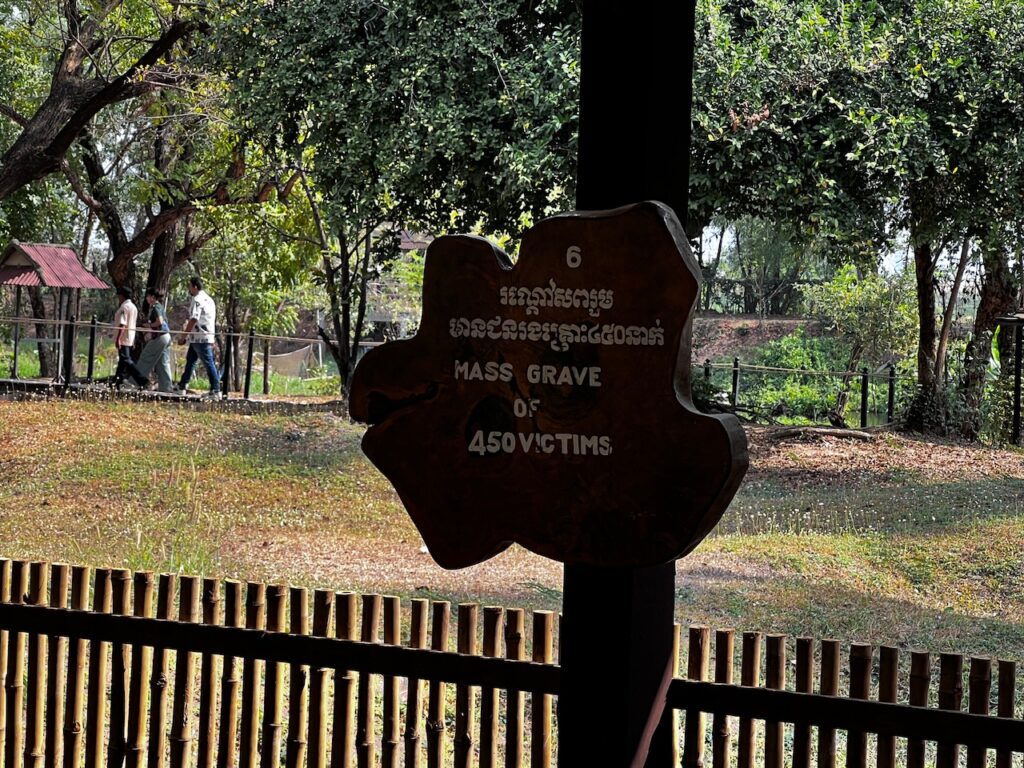
The hardest to see (for me as a mother) was the tree below. The reasoning for killing children was that if you kill the top of a tree the roots will re-grow so better to kill all the family so no-one can seek revenge.
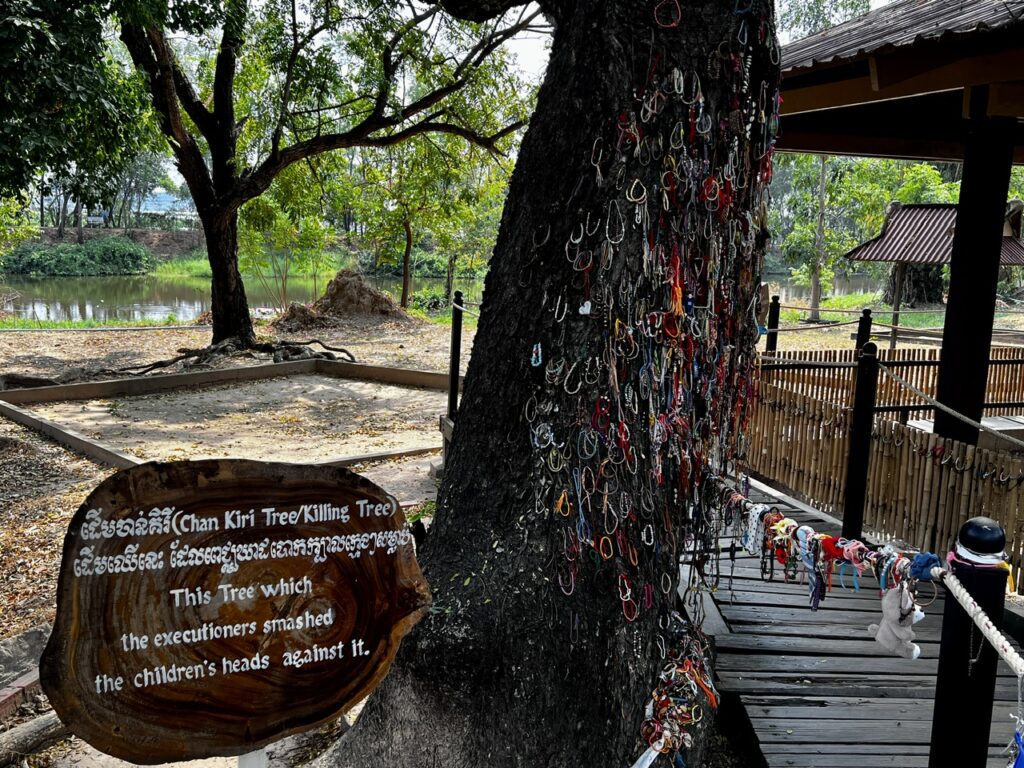
After heavy rain clothing and human remains are still being washed to the surface.



We sit under a tree and try to assimilate what we have seen. There are many questions from us for our guide and he tells us of the horrors experienced by his family.
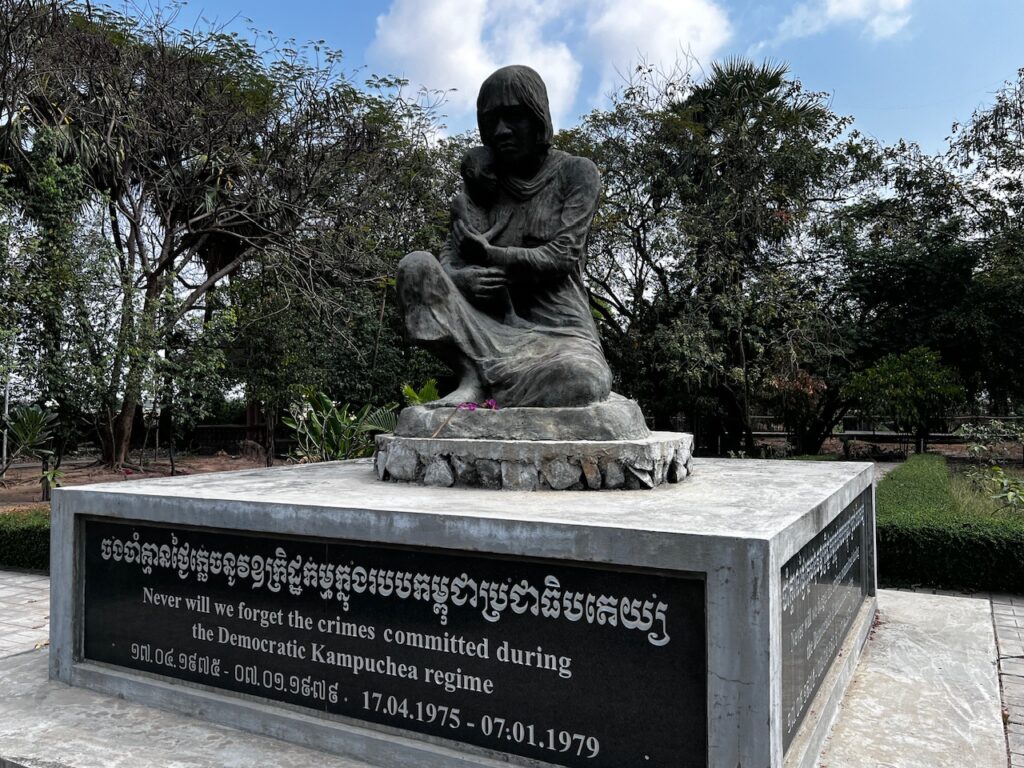
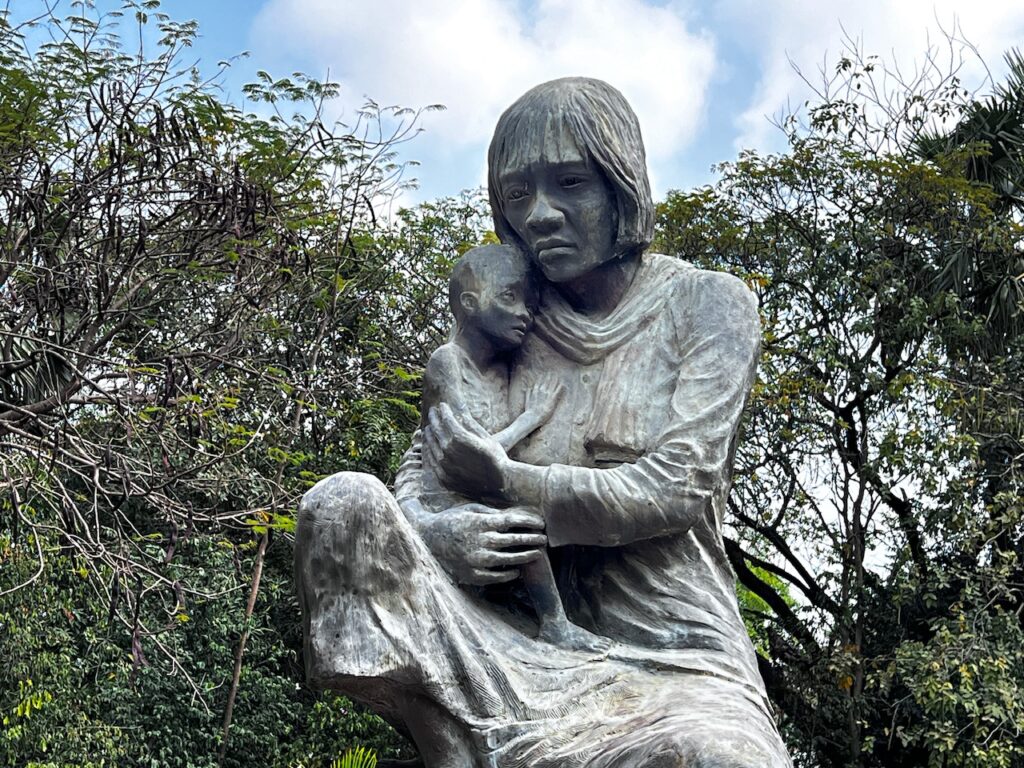
We drive back into Phnom Penh and stop at Tuol Sleng Genocide Museum, which is the memorial site of the S-21 interrogation and detention centre of the Khmer Rouge regime. It was originally a secondary school and blackboards are still on the walls.
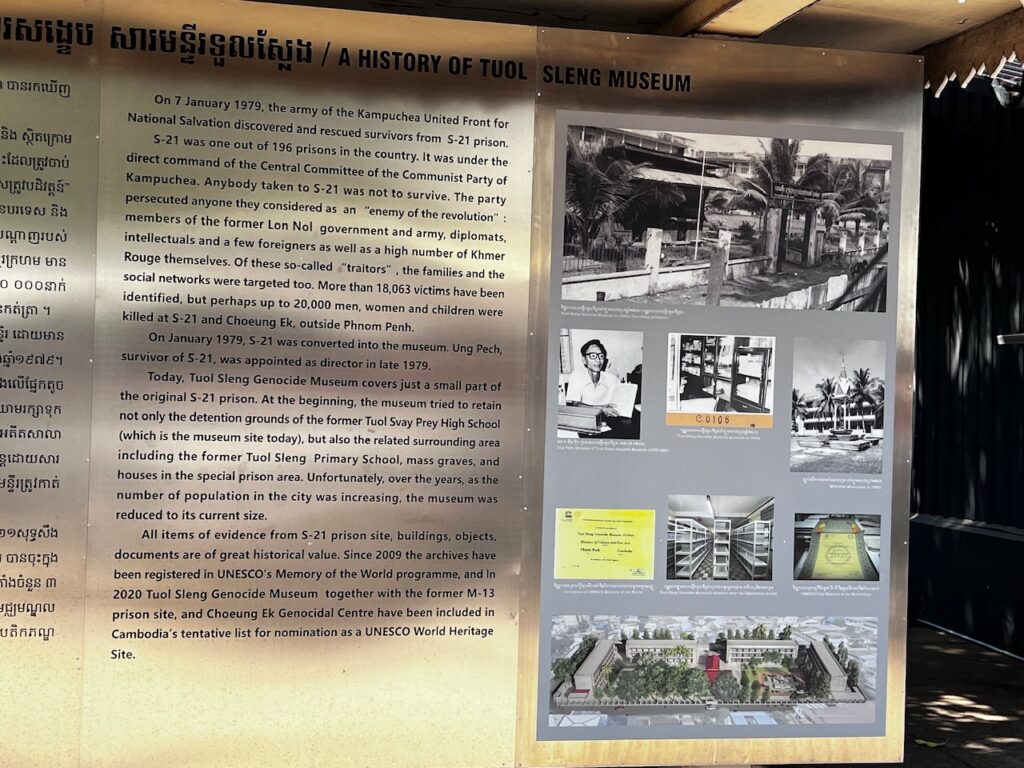
Razor wire covers the front of the building. The security rules would be impossible to obey.
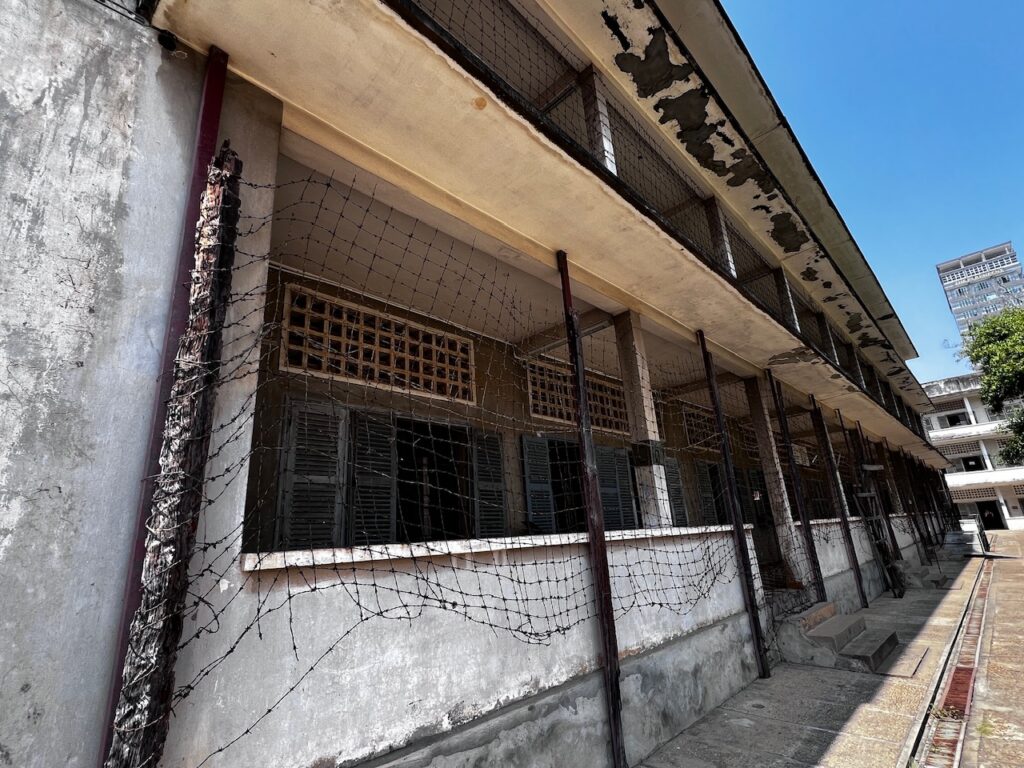


The interrogation rooms are grim and you can still see blood on the walls, floor and ceilings.
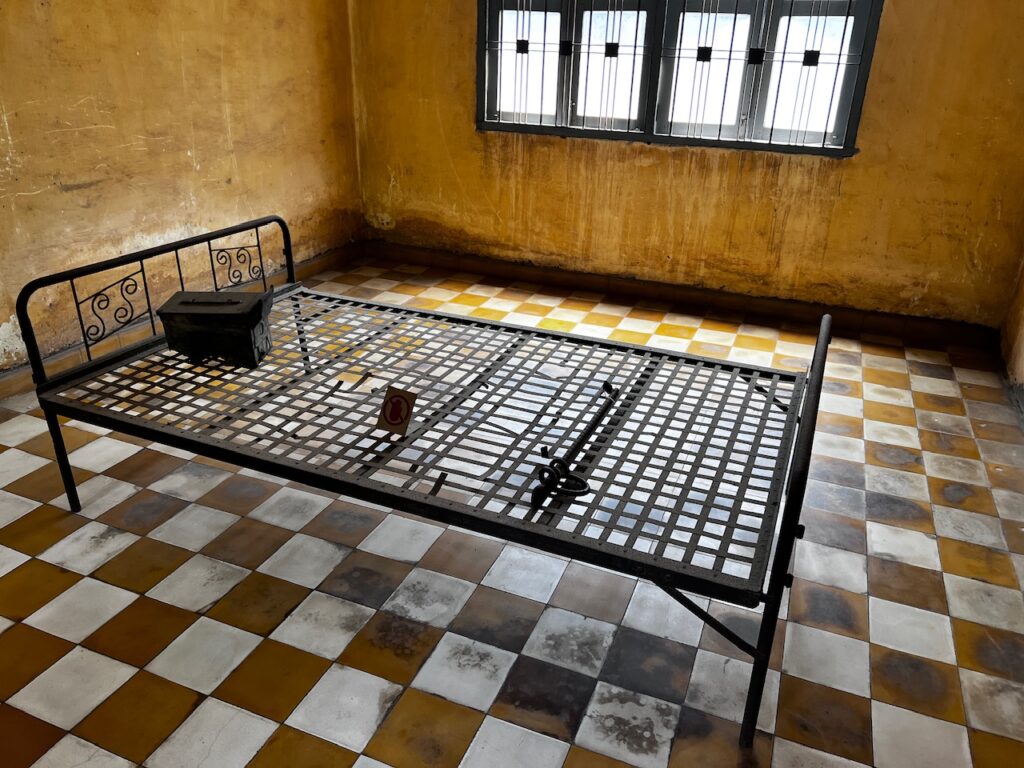
There were large rooms where many prisoners were shackled together. There were also isolation cells, which were tiny. The one below was occupied by Chum Mey, one of only 12 known survivors (18,o63 died here).


Chum Mey is now 94 and has written an account of his experiences, with all proceeds going to a victim support charity. I bought a copy from him and have now had a chance to read it. He is a remarkable man and has suffered unimaginable hardship.

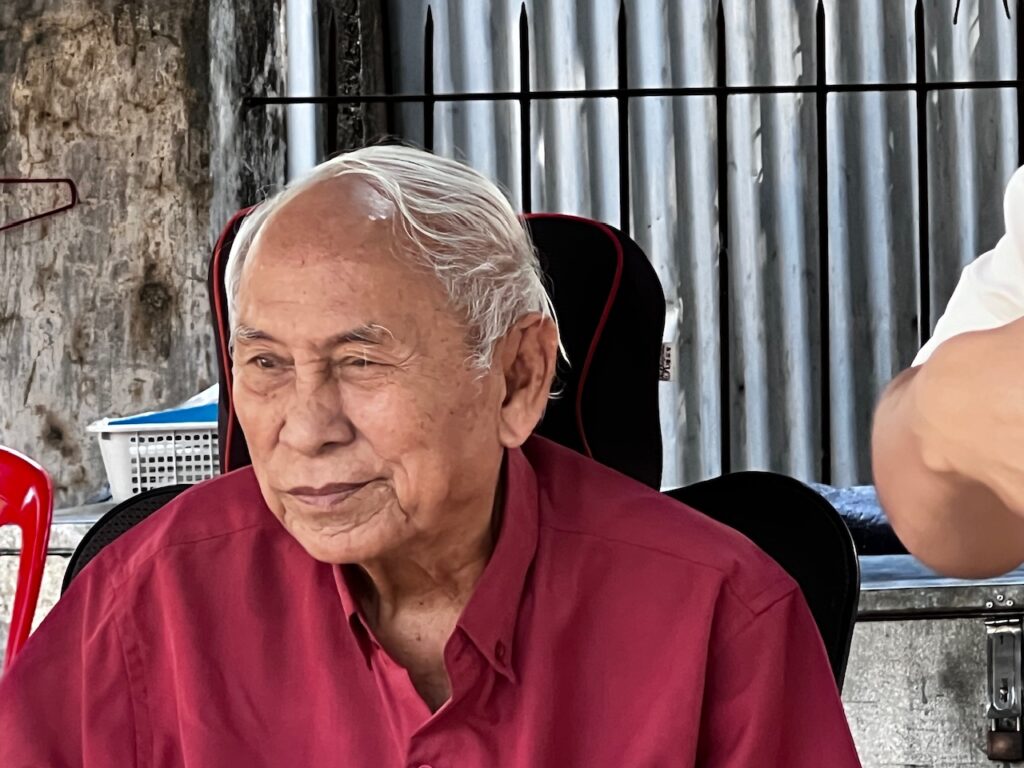

Many of the old classrooms are now dedicated to the victims and contain thousands of photographs of them. Yet again the pictures speak volumes. I found this very emotional and over-whelming.

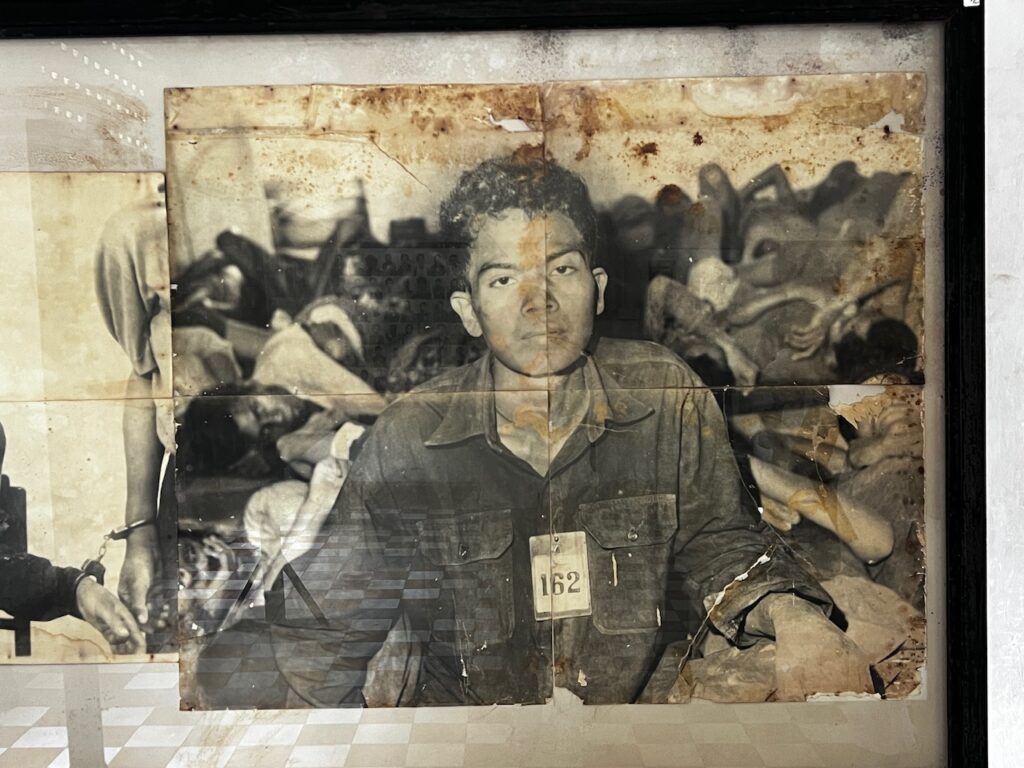
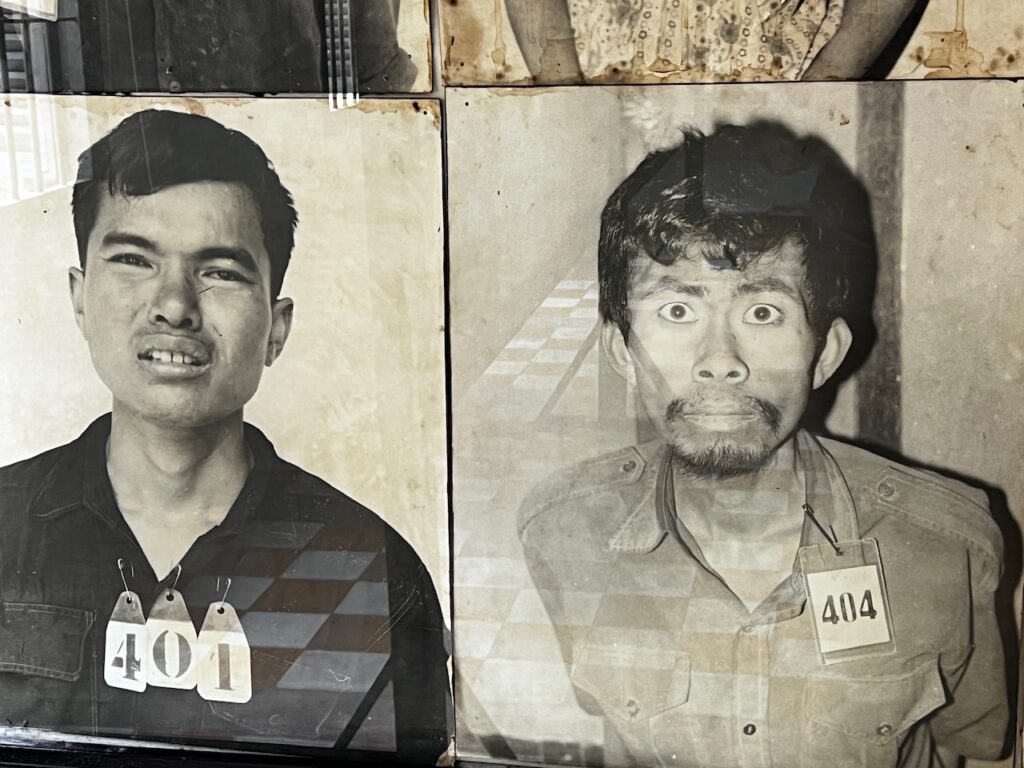
I leave you with the monument dedicated to all that died here.

We return to our hotel for a quiet afternoon to collect our thoughts. However Paul’s ears are still giving him trouble so we set off to a private clinic a short walk away. Here we are treated very professionally, ushered into a GP who is very thorough but recommends that Paul goes to the ENT Hospital. We are expecting a large bill but it is just $25. We take a tuk-tuk to the hospital, which is incredibly busy. We think that we shall be here a while, but could not be more wrong. We go to a counter give name, age, phone number and pay $10. We are shown into a room with about 10 doctors, lots of nurses, patients and sophisticated equipment. A doctor looks at Paul’s ears, says there is some wax to remove before he can test his hearing. We go back to the counter, pay another $5 and return to the same room where two nurses use an optic probe to look at the ear and then to carefully suction out any wax. Everything is displayed on a TV screen. Impressive. And also solves Paul’s hearing issue. A pretty good result for $15 and we have been there less than 30 minutes. They could teach the NHS a thing or two….
We need something to lift our spirits. What could be better than a Cambodian Kick Boxing Fight. A group of us think it will be fun and we set off across town in tuktuks. The roads are very busy and huge markets line the streets.

Our tuktuk driver is a lady and is great at multi-tasking. Not only can she negotiate the traffic, but she buys a mango and peels it whilst driving along. Good job!
We arrive at the ring. It does not seem overly busy and we are shown to ringside seats. Literally behind the judge. I am now questioning whether wearing a white shirt was wise….The matches are being televised, there are commentators behind us and big screens showing adverts.
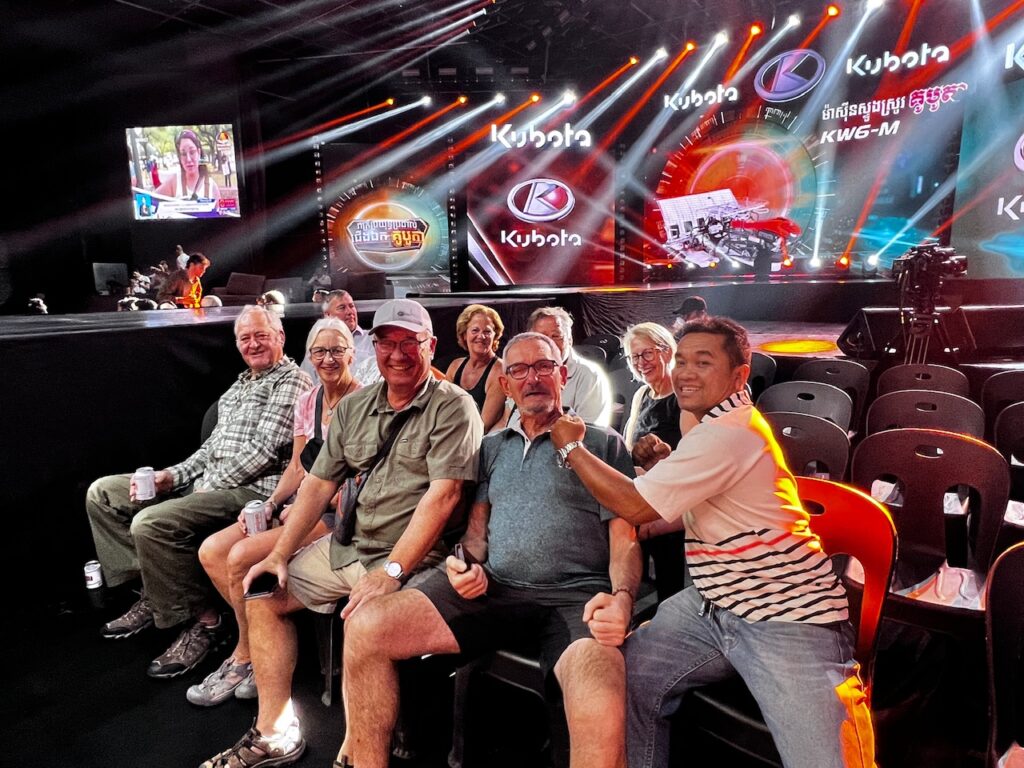
The fighting is fast and furious. It is very skilful and I found it much more enjoyable than a conventional boxing match.
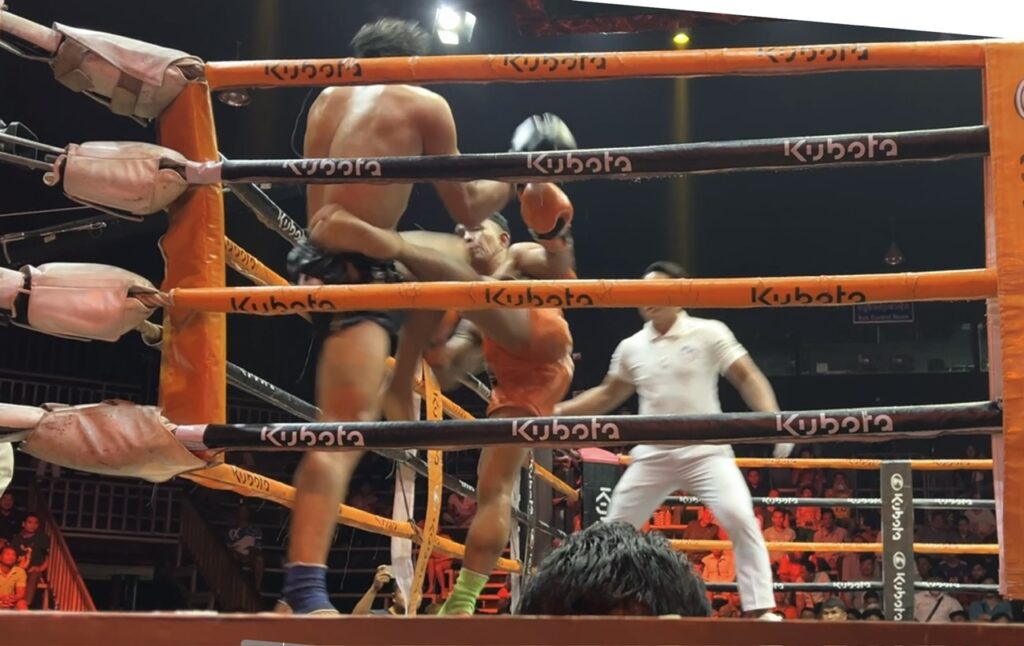
Some of our group feel the need to pose with one of the winners.

We leave the dark history of Phnom Penh behind us and can enjoy another early start and the best part of an 8 hour journey to Siem Reap. Lunch is at a lakeside restaurant. It’s a pretty location and I imagine even more so in the wet season when the lake water is deeper.


There is no doubt that we are packing a lot into this holiday but there is precious little downtime. We check-in at 16.00 and meet again for an orientation tour. We get our bearings and head for The Round Grill which Puna has recommended. It is a modern restaurant with air-conditioning and Puna tells us the food is excellent. We settle down into comfortable chairs at our table and order cocktails. We are looking forward to a quiet evening together away from the group. Sometimes you just want your own space and some of the group are quite loud. So how delighted are we when 8 of our group walk through the door? They invite us to join them. We politely decline.

Early mornings are wearing a bit thin and we have to leave at 04.30 to watch the sunrise over Angkor Wat. First we stop at the ticket office and have photos taken to go on the ticket. Then we walk in pitch darkness for about twenty minutes over the uneven sandstone path to Angkor Wat. We sit on the grass by some water where we are told we will get a great view and the reflection of the temple in the water. It is totally dark and there are too many people. They are all flashing torches and mobile phone lights around in the futile effort to see something. We seem to be surrounded by smokers and giggly teenagers. Frankly it is a pretty unpleasant experience. After a very unpleasant and uncomfortable 90 minutes in the dark we move. Now there is an inkling of daylight and pretty much everywhere else looks less crowded.

As the sky lightens I think I shall try out a test shot with the camera. It does not appear to be working and that would be because the battery is still in the charger in the room. Bother! At least I have the phone.


The photos are never going to be great as the sun is directly behind the temple. From a photographer’s point of view it would have been far better to come in the afternoon, although it would be very hot. Angkor Wat would have the sun shining on it and we could have been awed by seeing its grandeur as we walked across the 200 metre wide moat on the old sandstone causeway. Our guide tells us not to enter the temple until we have all met up after breakfast. We are close to the entrance and a security man tells us the temple is now open and we can go in. We do not hesitate. We can get a quick glimpse before the crowds arrive. Hurrah!

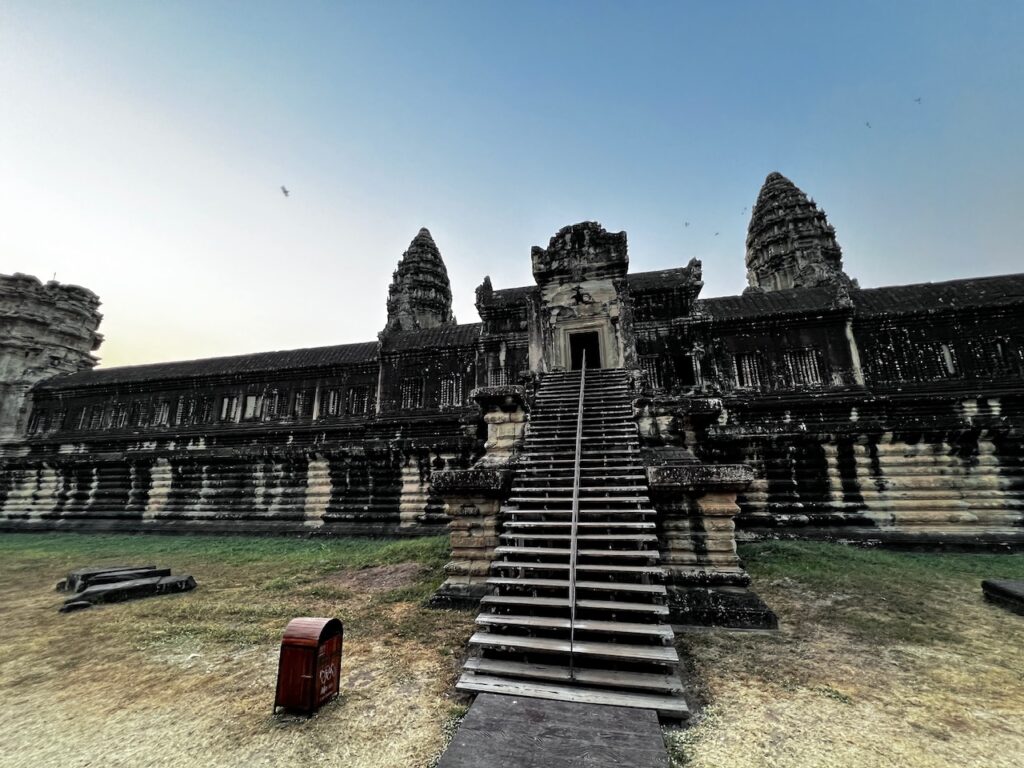




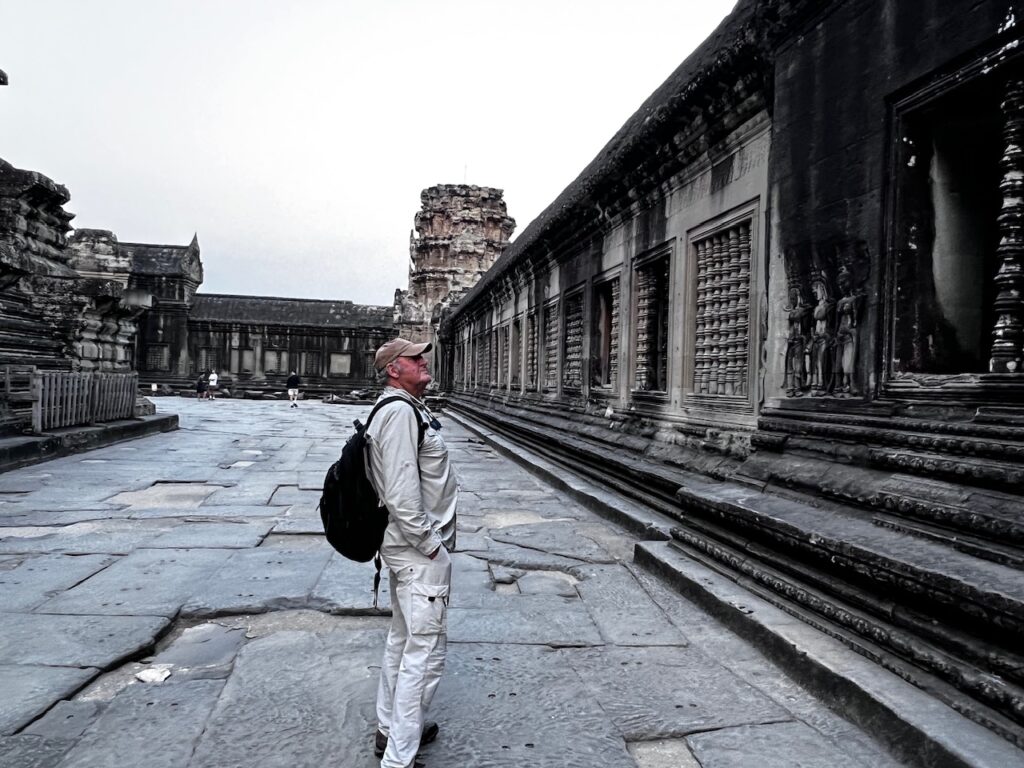
We gather after breakfast and are given a briefing about the temple. It took 37 years to build and involved 300,000 labourers. That is some ego trip as a memorial to yourself when you die! The sandstone was brought from the mountains 60 km away. It was floated on barges along the river and then transported by elephant. Most stones have holes in them which is where poles were put to lift them.

Then it is time to go inside. What is amazing is how well preserved everything is after 1000 years or more – apart from many of the Buddha heads which have been cut off and stolen….
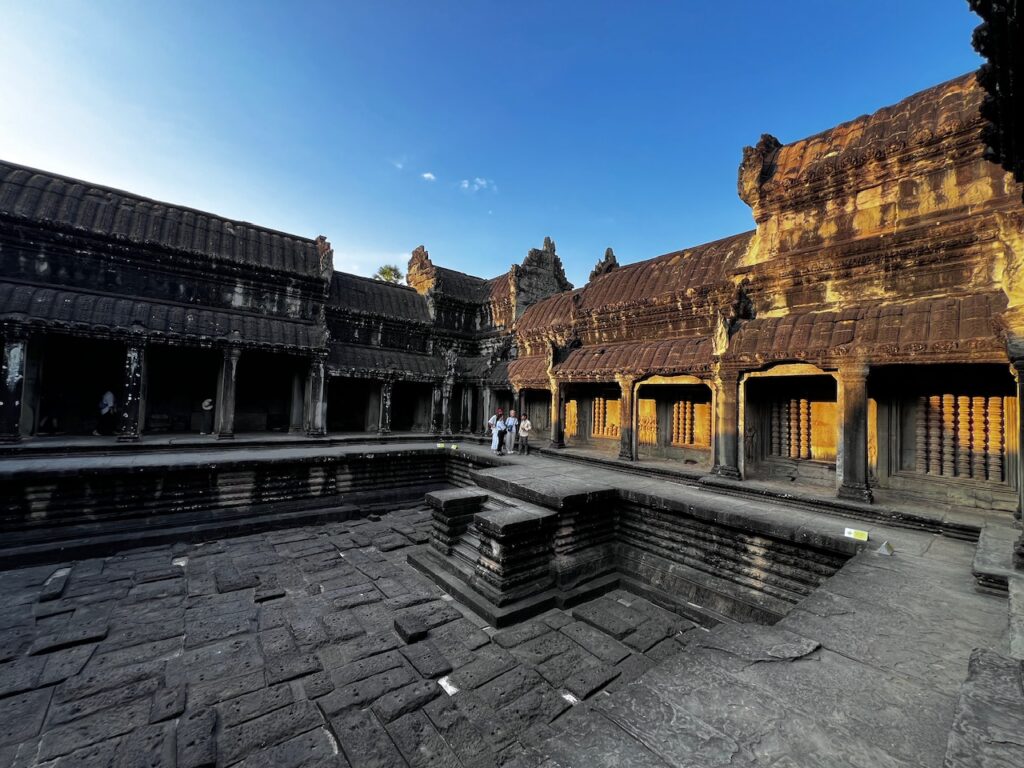







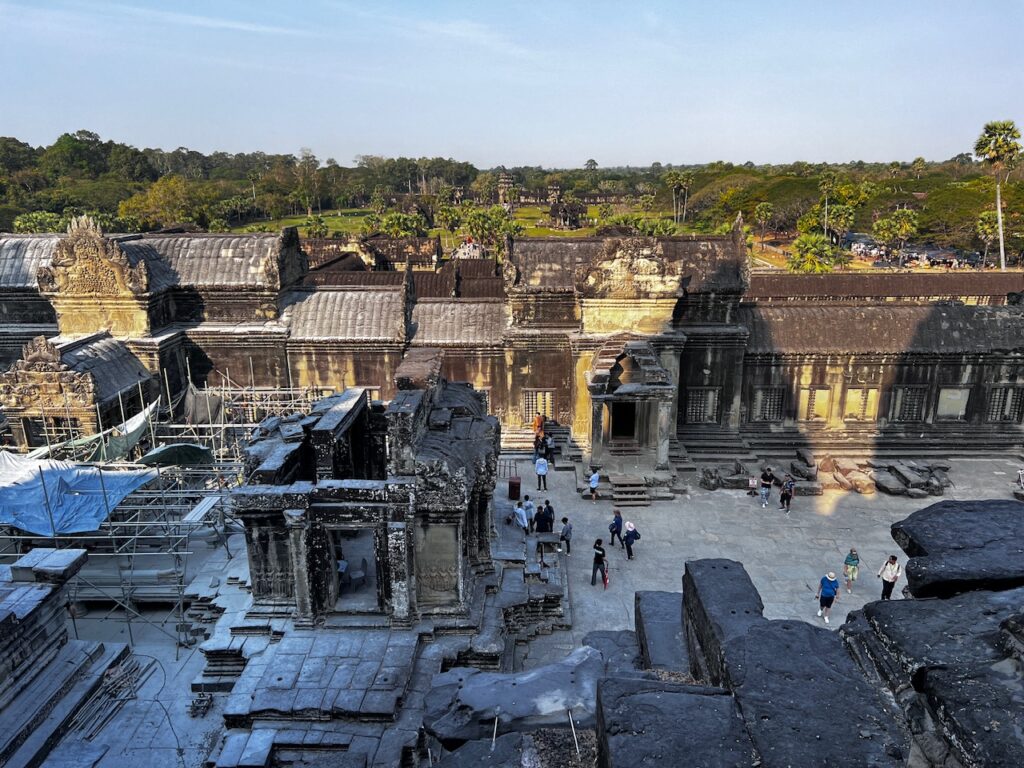





A short drive stakes us to Ta Prom temple which was used for the filming of Tomb Raider. It is completely different to Angkor Wat, smaller and in places largely taken over by the jungle. It is quite crowded but nonetheless impressive for that.











Huge kapok trees snakes their way through the buildings like some alien beast. It really is quite something to see, although of course this is slowly destroying the temple.











There is a lot of restoration work being carried out now, which is good to see.
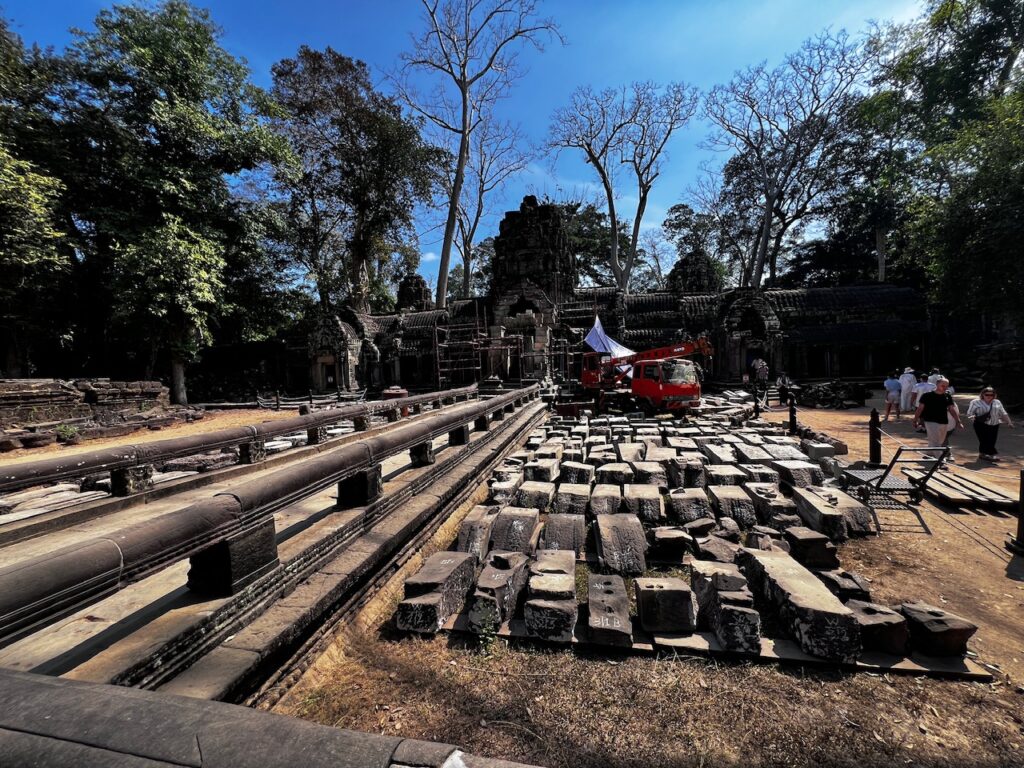
Outside the temple, a group of musicians are playing traditional instruments. They all have severe injuries from landmines. It is yet another grim reminder of the enduring effects of the war. We stand and watch, thank them and of course we make a donation, though in the scheme of things it feels pretty inadequate.
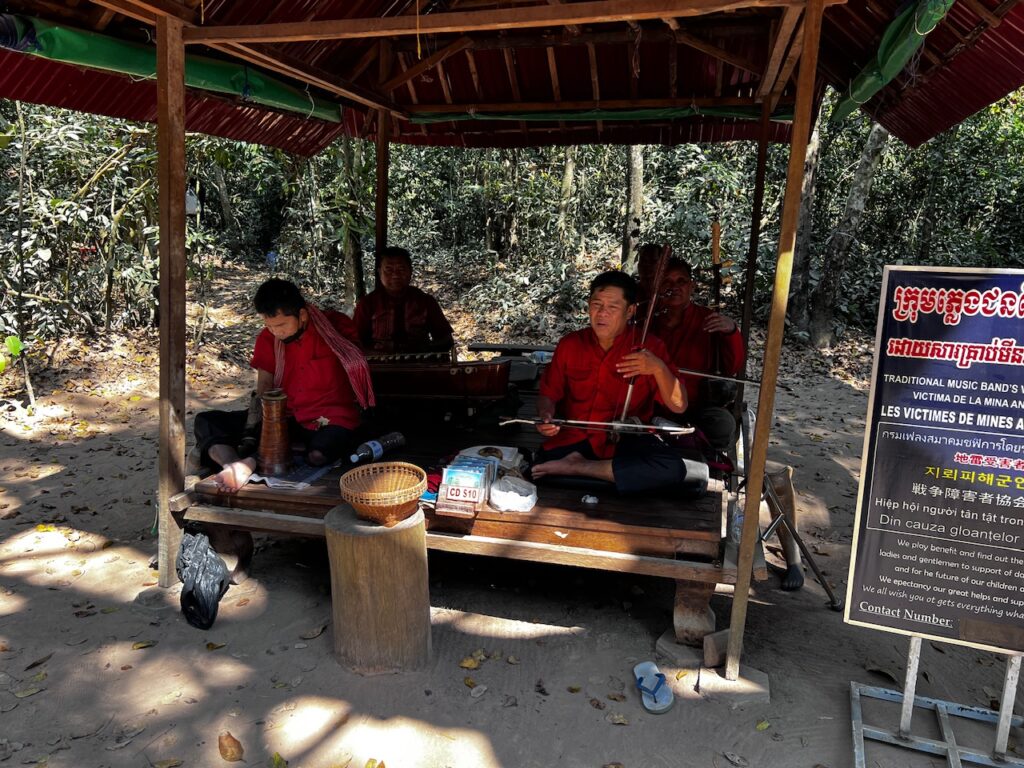
We visit one more temple The Bayon of Angkor Thom before going for a much needed nap. It is a Buddhist temple built in the 12th or 13th century and known for its many smiling faces.














This evening we eat at the New Hope restaurant, a project supported by G Adventures. The meal is excellent and it is nice to think that the proceeds from our meal are helping to fund the training program.
Planeterra Project
New Hope Foundation
In 2010, Planeterra worked with New Hope Outreach Centre to build a training restaurant to support young Khmers living just outside of Siem Reap. Over $60,000 CAD in donations were raised through one of our partners G Adventures, to build the restaurant and provide professional training to young adults that expressed interest in the hospitality industry. The training program is a six-month commitment and our ground partners assist with full-time job placements in one of the many burgeoning hotels, resorts and restaurants in the Siem Reap region.
Since the restaurant became fully operational in 2011, our partner G Adventures has annually sent thousands of customers and travellers to the training restaurant. Trainees of this program have found placements in careers in the hospitality industry. The proceeds from the traveller’s meals support over 1,000 student’s education and 1,000 free medical checkups through New Hope’s Outreach program, reaching some of the poorest areas outside of Siem Reap. New Hope’s programs go beyond training and education, providing health care through their centre, and providing fresh water to the student’s families to reduce sickness. In 2019, New Hope engaged children in waste reduction programs which helped to build their respect for the natural environment, and create a safer, cleaner space.
Planeterra.org
This is our last day in Siem Reap. Tomorrow we shall have a long drive across the border and back to Bangkok. As such most people have decided to take the day easy. We want to visit one more temple and it turns out no-one else in the group wants to go so we have a private tour and I would say it was definitely our favourite. But first we make a stop at the South Gate to Angkor Thom.
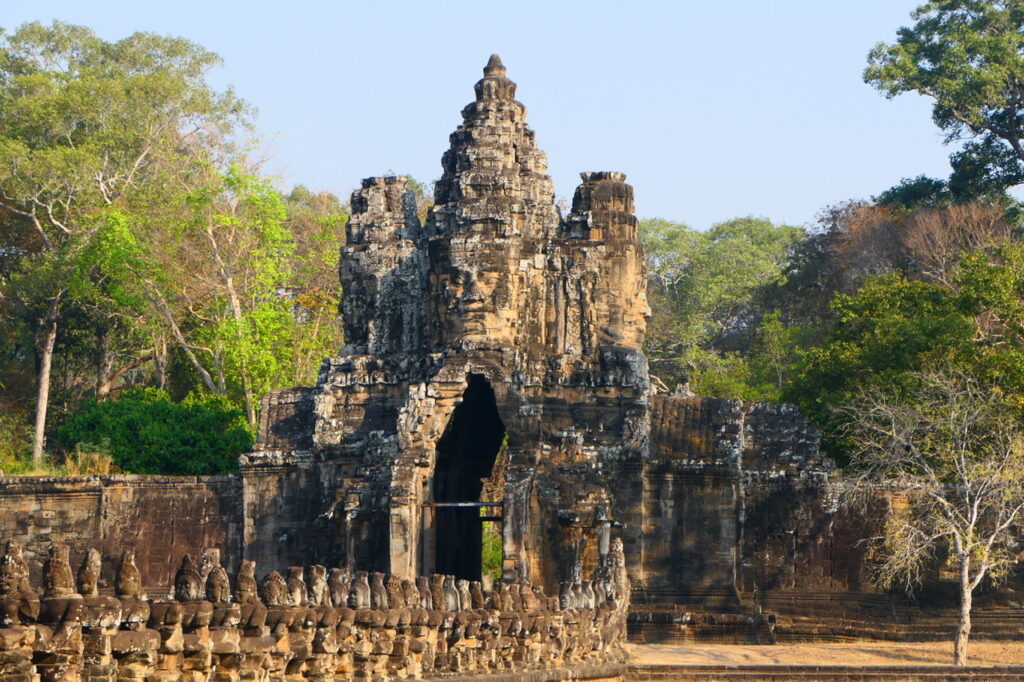
A grand causeway crosses the 100m wide moat which is flanked on each side by 54 stone giants pulling on the body of the Naga serpent.
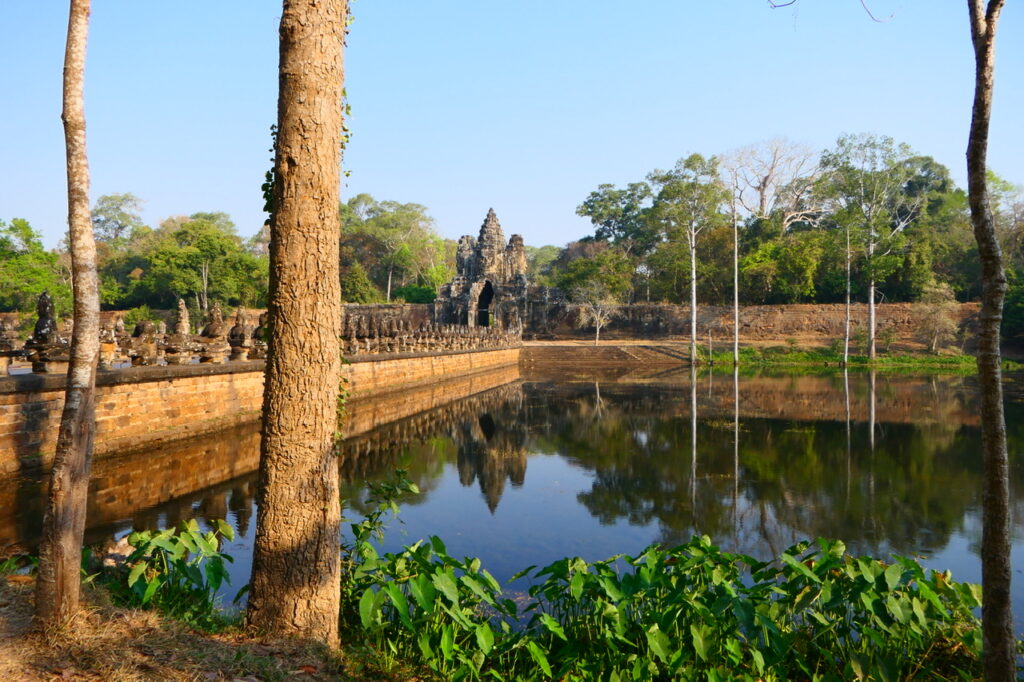

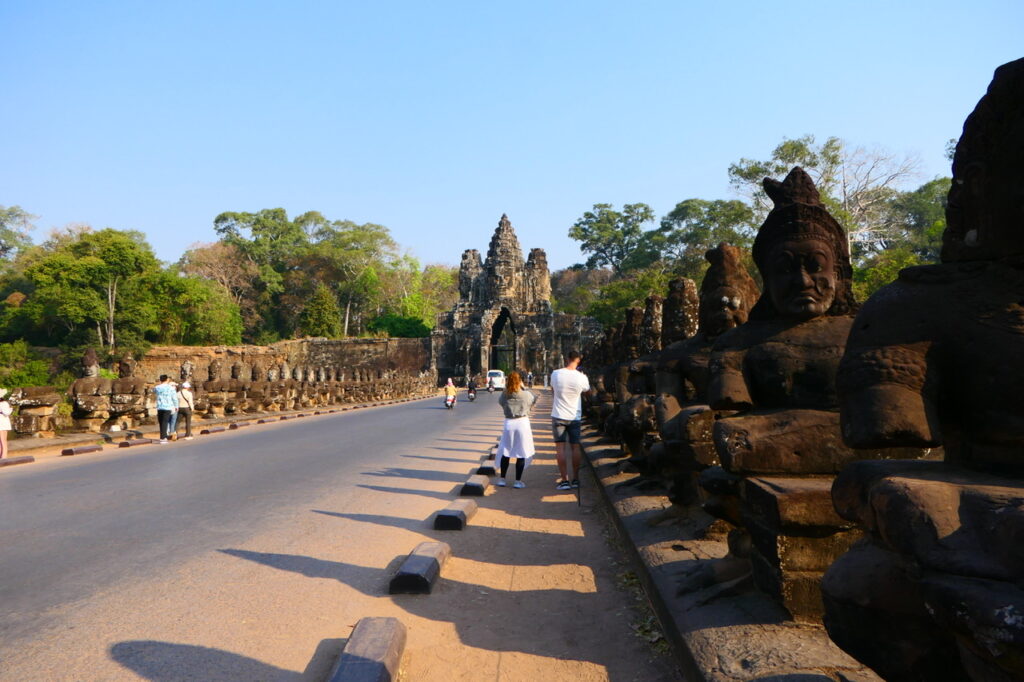
On one side, the giants represent Devas featuring slender oval eyes and a casual smile.


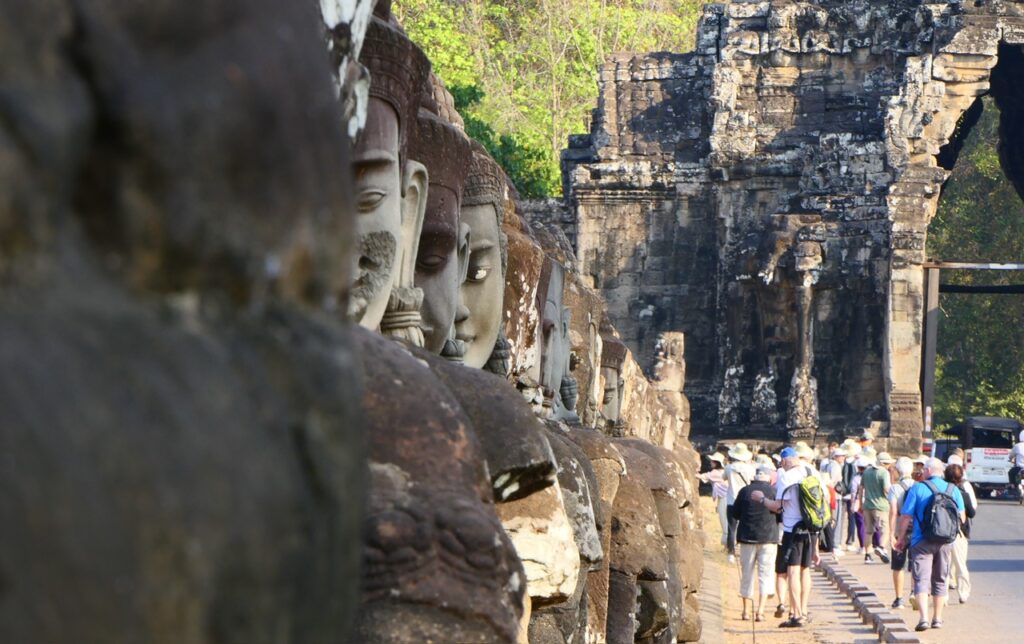
On the other side they depict Asuras with round bulging eyes and grimacing faces. They represent an endless tug of war between good and evil. This symbolism is displayed in all of the temples we have visited.
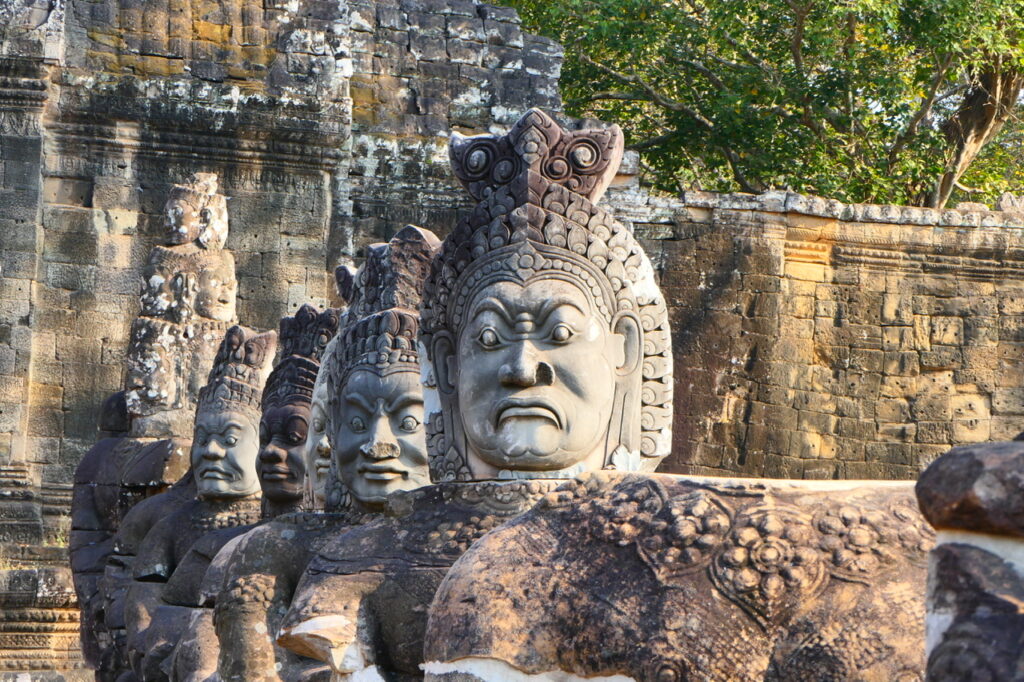

We continue to Preah Khan Temple which is accessed by a path through the jungle. It is great there is no-one part from the two of us and our guide JB. He tells us that wherever we see a termite mound there was once a building and there are a lot of termite mounds. We walk for 20 minutes and arrive at a clearing where we get our first glimpse of the temple. It feels like we are the first people to ever set eyes on it although of course that is not the case.


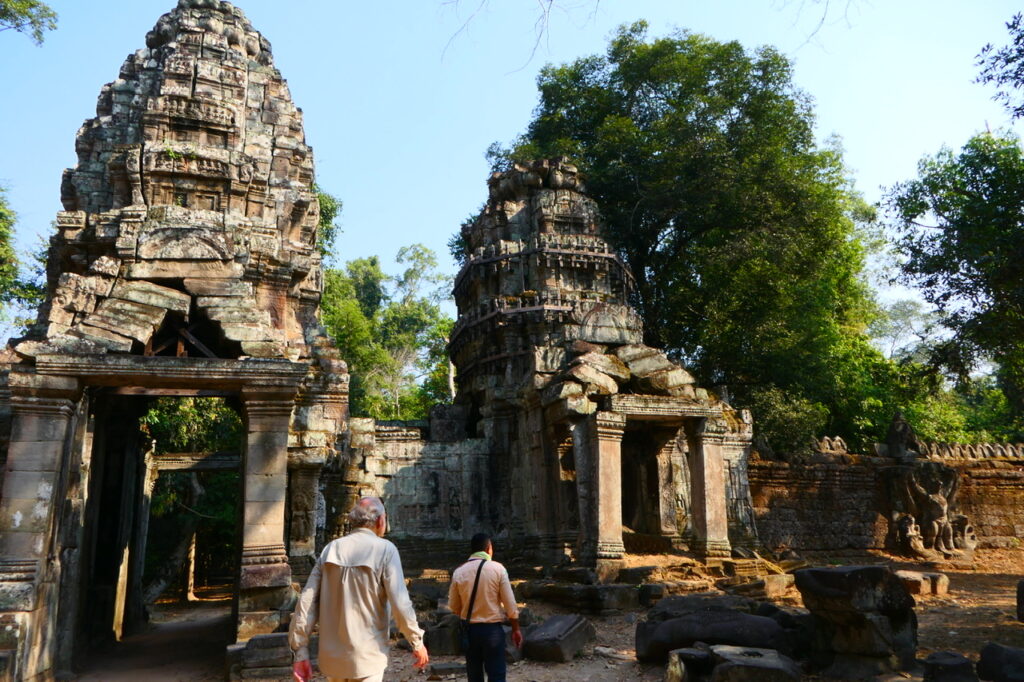
The temple is in a poor state of repair and trees are encroaching upon it, but it no less interesting for that.
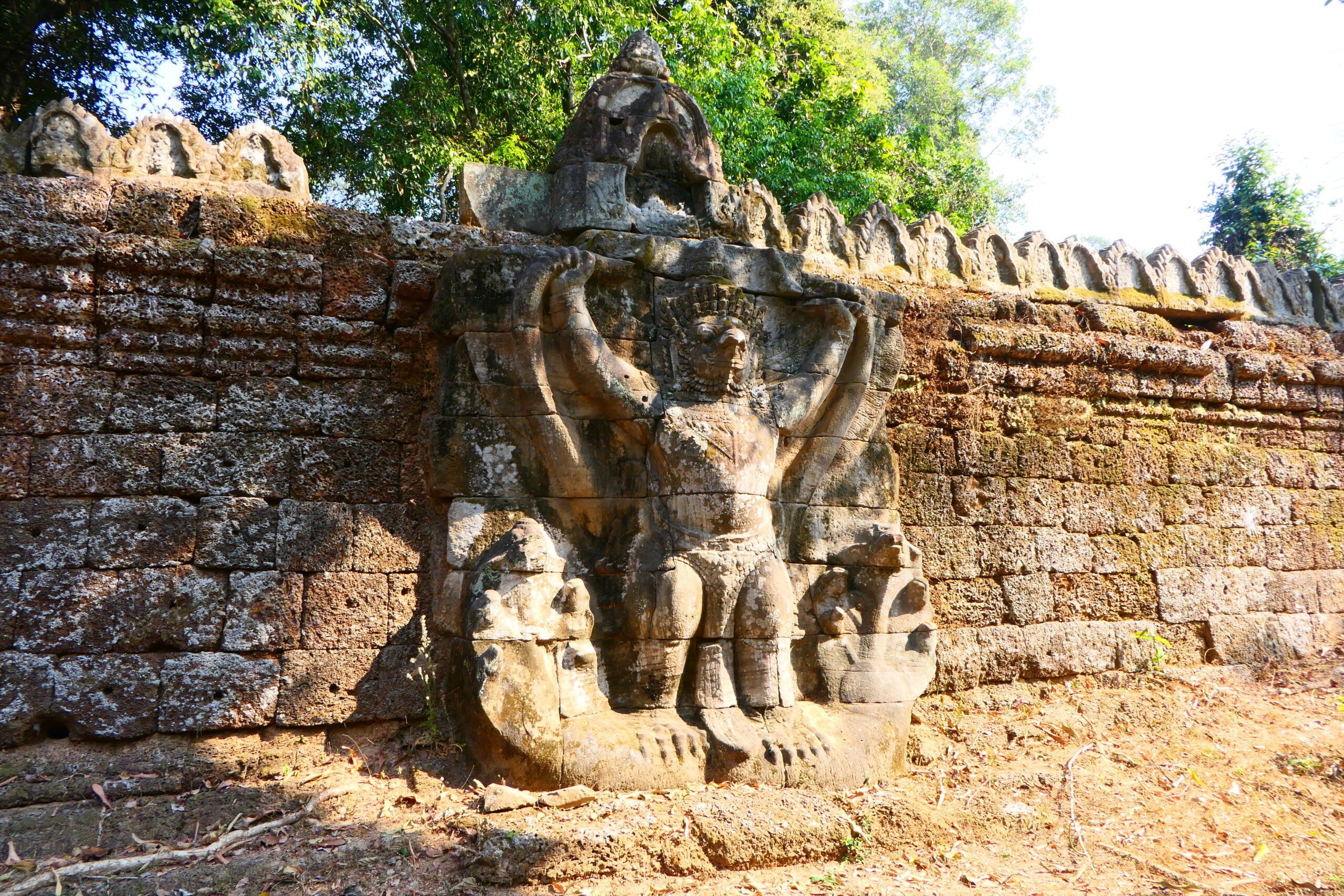


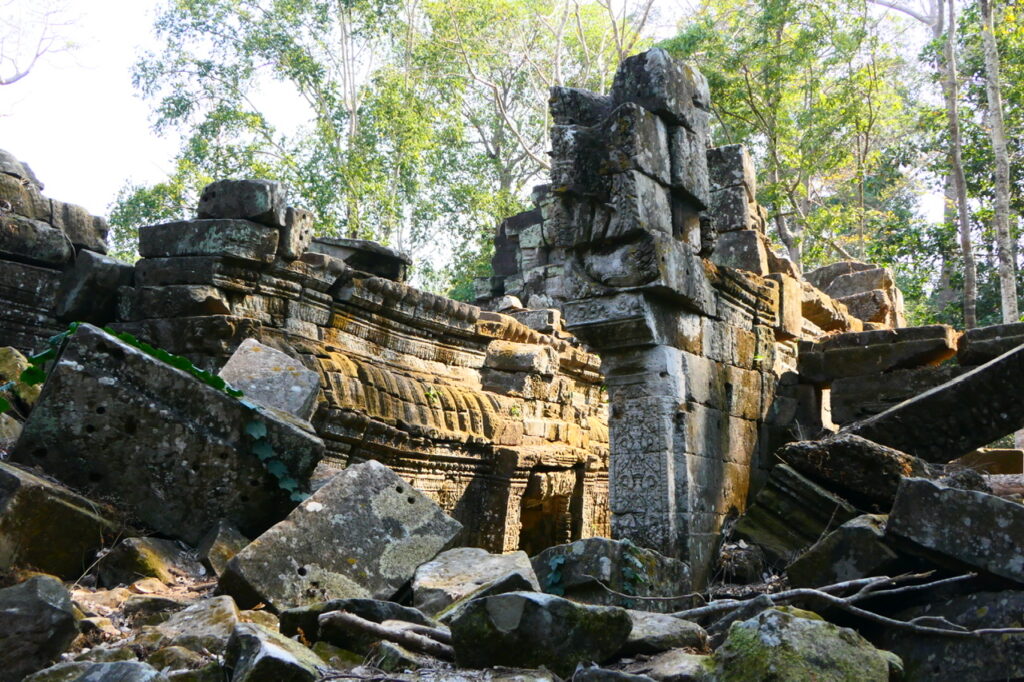

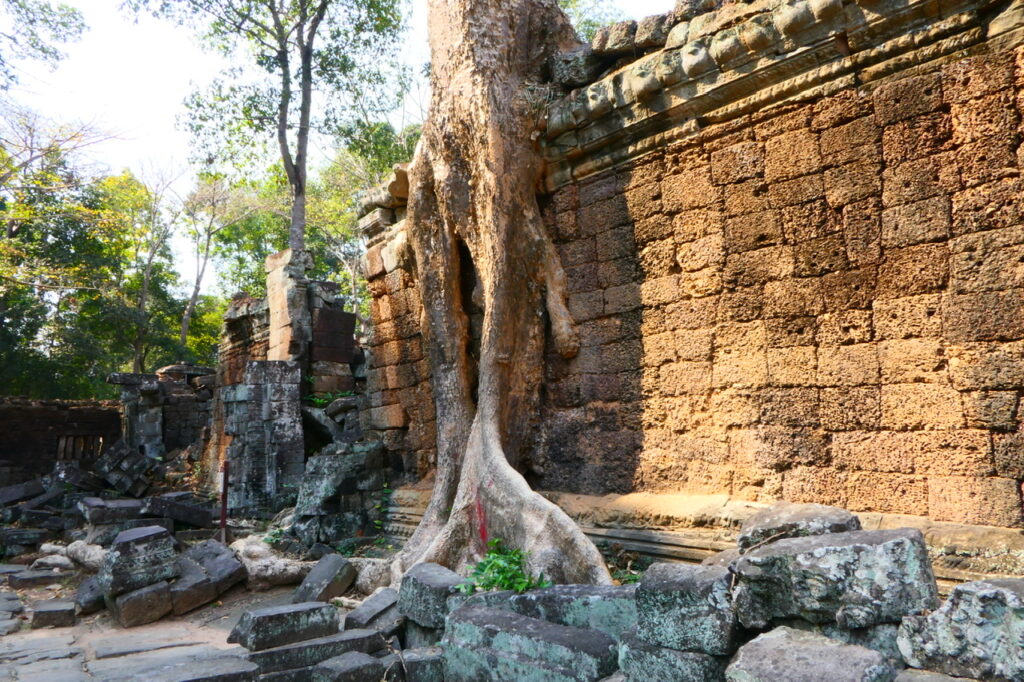

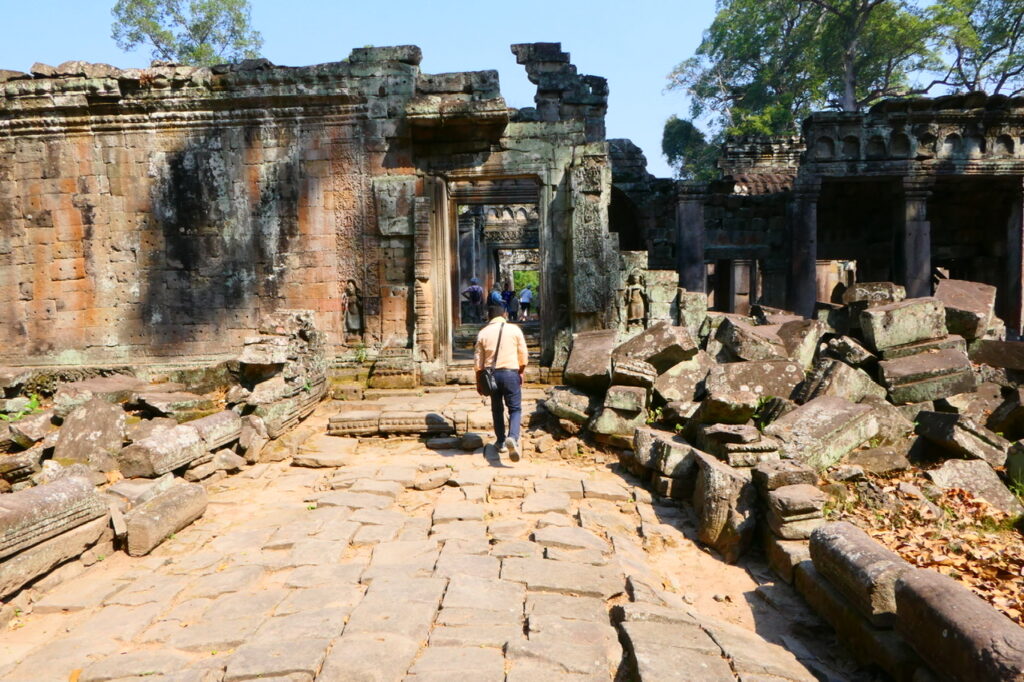
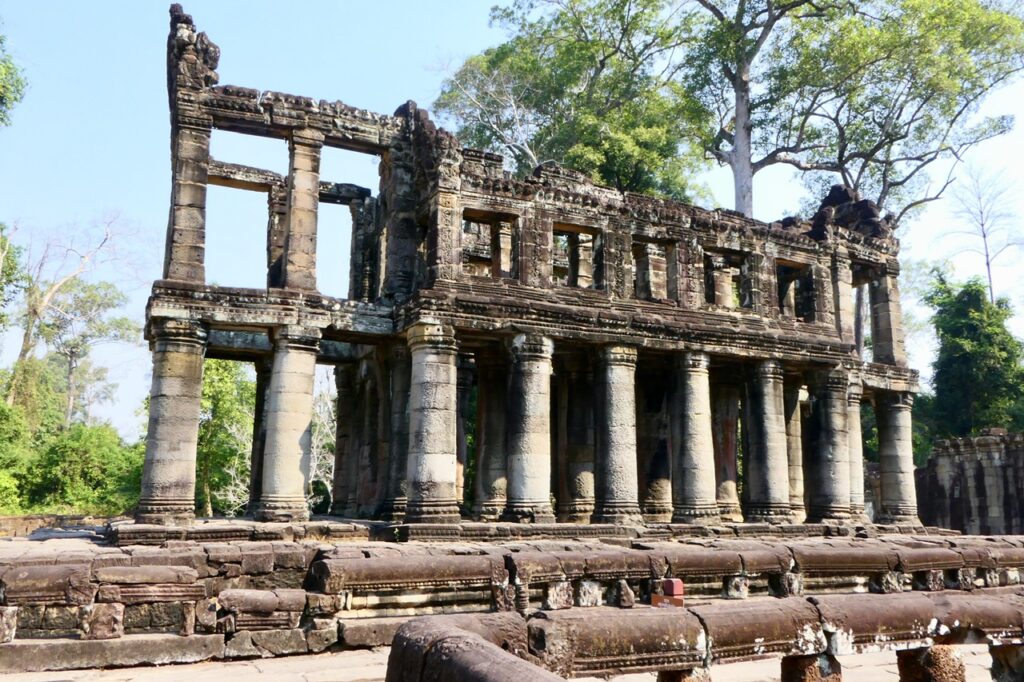
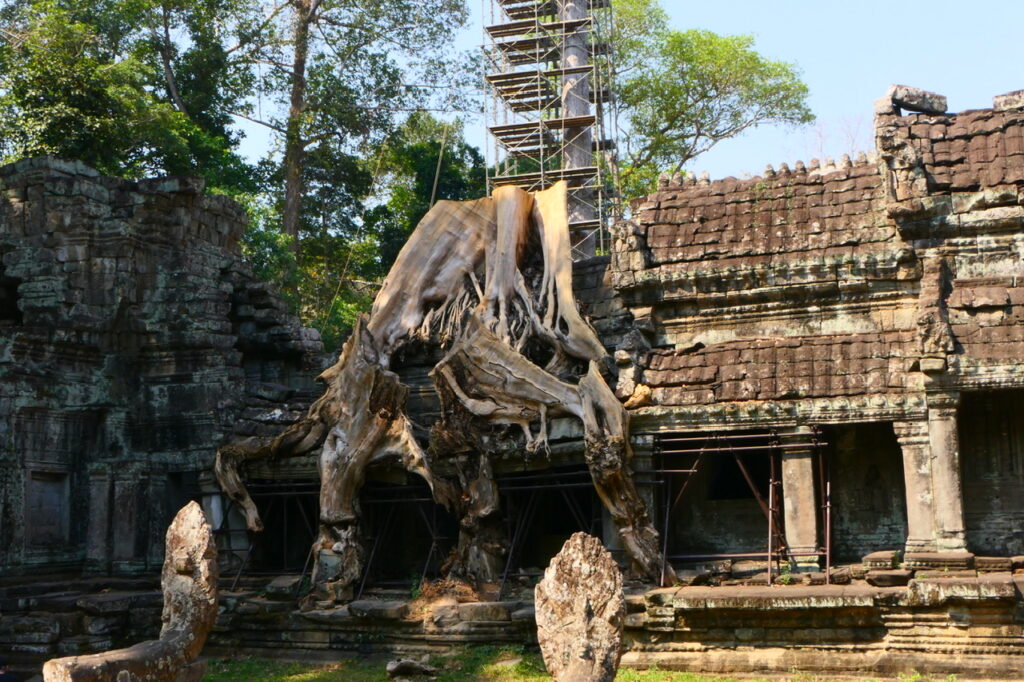


One of the great things about having a one-to-one experience with a guide is that you have the opportunity to get to know him. JB tells us about how difficult the war was for his family. They were wealthy and had a large house. The Khmer Rouge took it over and turned it into a prison. Many of his family disappeared and after the war the house was burnt down and the family were left with bare earth and just the clothes on their backs. Twenty years ago JB started being a tour guide and set up his school 10 years ago, supported by his earnings from being a guide.

Below is an excerpt from his Facebook site. What an incredible, inspirational and caring man.
Greetings from Cambodia! I hope you and your family are doing well. It was a real pleasure being your tour guide in Cambodia and a privilege to share the history, culture, and heritage of Cambodia with you.
Today, I want to share my life’s mission and the story of JB School, which brings hope to children in Meanchey.
I founded JB School in 2013 to provide free English and computer literacy classes to local children in Meanchey, Siem Reap Province. When I first set up the school, I would teach 150 children in the area next to my parents’ house. Today, JB School has grown, and we now offer daily lessons to more than 400 children. Most of them come from farming families living well below the poverty line. They attend our school after their regular classes, and since 2013, JB School has been able to provide free education to over 4,500 students.
Growing up in this very community under difficult circumstances, I understand the transformative power of education. As a child, I walked many kilometers to school every day, sometimes wading through floodwaters with my books on my head. Despite the challenges of post-war Cambodia, I achieved my dream of learning English and becoming a tour guide in 2003. JB School was born from my desire to give back to the community that raised me and to help the next generation realize their own dreams.
That’s why I am reaching out to see if you would consider supporting JB School. Your generosity and support can help ensure that these children continue to have a place where they can grow, learn, and dream.
Operating the school requires a monthly budget of $1,530, and meeting this budget each month is a significant challenge.
Every contribution makes a difference. Whether it’s funding a teacher’s salary, covering electricity bills, or providing notebooks for our students, your kindness can directly shape the future of a child.
Thank you for taking the time to read this and for considering being a part of our journey. Your friendship and support mean the world to me, and I hope we can work together to bring hope and opportunity to the children of JB School.
With gratitude and warm regards,
Chamroeun Sok (Mr. JB)
Founder, JB School
JB takes us to a lovely local restaurant next to a very impressive man-made lake which was built as the Royal Swimming Palace. In the centre there was a grand swimming platform but there is little of it left now.
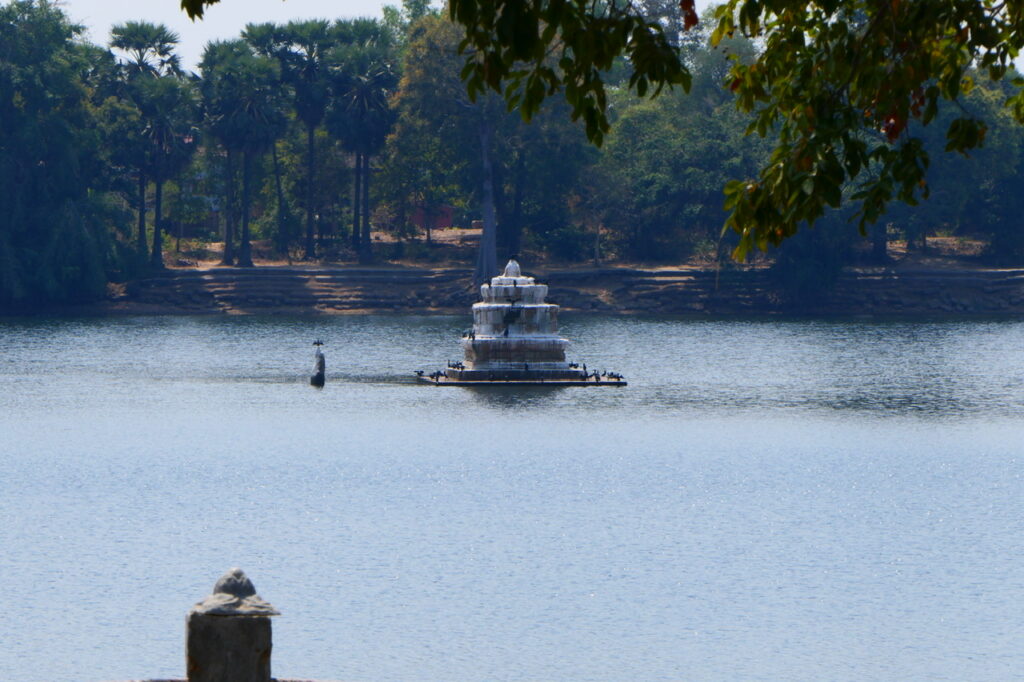
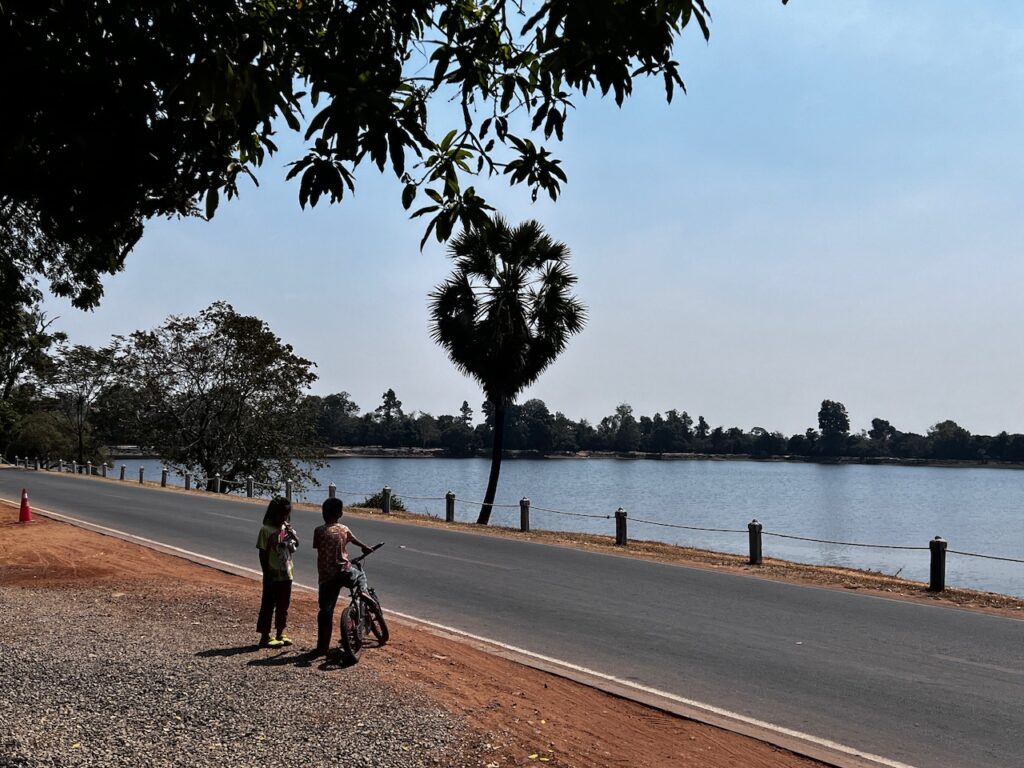
We spend a lazy afternoon and in the evening for a change from oriental food find a good pizza restaurant. We then whole away sometime in a brand new cocktail bar which was really up-market. It even had bidet toilets with heated seats that wash and dry your nether regions automatically! I wasn’t wearing my glasses so pushing the right buttons for the right function was a slight challenge. Definitely a first world problem!

Next day is a travelling one with a long drive across the border into Thailand and back up to Bangkok. I’d forgotten just how sprawling and immense Bangkok is and the air pollution is truly terrible. It has been a fantastic trip. A real travellers adventure with so many different encounters and much to provoke a lot of thought. There is no doubt that we have returned home as different people. It would be impossible to not be changed – I hope for the better – by all that we have seen and experienced.

Lynne
All the countries you have visited each has its own story to tell. Its history, its culture, its scenery and its people; every piece making up the whole.
You have certainly documented so much a great deal of which, on this trip, cannot all be depicted in pictures. On this occasion the words are powerful.
You know I cannot agree with your comment in that you have to visit such sites as The Killing Fields to understand the history. We didn’t visit on our trip purely based on the childrens killing tree. I am visualising even as I write the childrens heads and bodies being thrown against the tree.
It is the same reason I couldn’t visit Auschwitz it doesn’t mean I can’t appreciate what happened there.
On a happier note – you must have enjoyed an amazing time and taken away many memories of Indochina.
Maggie
It certainly was a trip with huge variety and travelling as we did (often like the locals) did ensure we really got a feel of each country and an understanding of the people and culture. The dark history was challenging, the temples and monuments uplifting, the rubbish everywhere not so appealing, the people delightful, the crowds and traffic not so much, the food interesting and tasty and generally not that spicy apart from Thailand. A very worthwhile, interesting and educational trip.